Raleigh | Durham | Chapel Hill
May 29, 2024









































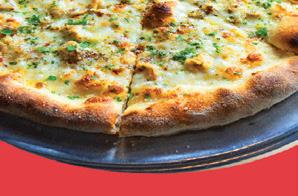


















Que Chula Es Puebla, a family-run Raleigh food truck, serves up Pueblan dishes with care, p. 24

Preeti Waas is going all in on creating the inviting Durham space she’s always dreamed about, p. 12

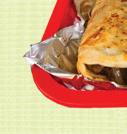

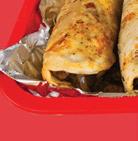


Chef Jeff Seizer is driving a creative vision for Ponysaurus’s new location in Raleigh Iron Works, p. 10

























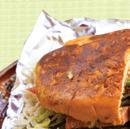












The INDY FO OD








































... and more!
• Durham food venues grow up
• Peek inside chefs' home fridges


• Scott Crawford's new restaurant, Brodeto

Raleigh W Durham W Chapel Hill
6 The City of Durham's cemetery maintenance policy is raising questions. BY LENA GELLER
8 Voters in Chapel Hill and Orange County will see bonds on their ballots this fall. BY CHASE PELLEGRINI DE PAUR



The INDY FOOD Is



10 Chef Jeff Seizer is driving a creative vision for Ponysaurus's new location in Raleigh Iron Works. BY NATION HAHN
12 Preeti Waas is going all in on creating the inviting Cheeni space of her dreams in Durham. BY
LAYLA KHOURY-HANOLD
14 With the recent openings of restaurant Brodeto and bar Sous Terre, Scott Crawford has forged a path forward out of the dark pandemic years. BY NATION HAHN
16 We asked five Triangle chefs, restarateurs, farmers, and small purveyors what they keep in their refrigerators at home. BY LENA GELLER
21 How Durham's culinary entrepreneurs are navigating the hospitality industry's challenging new landsape. BY JUSTIN LAIDLAW
24 Raleigh food truck Que Chula Es Puebla serves up Pueblan dishes with care. BY GABI
MENDICK
CULTURE
26 Incoming! Norwegian Mountains, Vicious Satire, and Shifting Perspectives. BY GLENN MCDONALD
CORRECTION In our feature two weeks ago about tenants of the Lynch family's East Durham properties, we misstated the acronym for Durham's NIS Department. It is the Neighborhood Improvement Services Department, not Neighborhood Inspection Services. And in 15 Minutes, author Serena Kaylor's protagonist's name is Marlowe Meadows, not Marlon Meadows.
VIA UNSPLASH, PEXELS, AND WIKIMEDIA COMMONS
W E M A D E T H I S
Publisher John Hurld
Editorial
Editor-in-Chief
Jane Porter
Culture Editor Sarah Edwards
Staff Writer Lena Geller
Reporters
Justin Laidlaw
Chase Pellegrini de Paur
Contributors
Mariana Fabian, Desmera Gatewood, Spencer Griffith, Carr Harkrader, Matt Hartman, Tasso Hartzog, Brian Howe, Kyesha Jennings, Hannah Kaufman, Jordan Lawrence, Elim Lee, Glenn McDonald, Nick McGregor, Gabi Mendick, Cy Neff, Shelbi Polk, Byron Woods, Barry Yeoman, Sam Overton

The
chicken and dosa
at Cheeni's (See page 12.)
Copy Editor
Iza Wojciechowska
Interns
Matthew Junkroski
Mila Mascenik
Avery Sloan
Creative
Creative Director
Nicole Pajor Moore
Graphic Designer Ann Salman
Staff Photographer
Angelica Edwards
Advertising
Publisher John Hurld
Director of Revenue
Mathias Marchington
Director of Operations
Chelsey Koch
Circulation
Berry Media Group
Membership/subscriptions
John Hurld
INDY | indyweek.com
P.O. Box 1772 • Durham, N.C. 27702 919-666-7229
support@indyweek.com to email staff directly: first initial[no space]last name@indyweek.com
Advertising sales sales@indyweek.com 919-666-7229
Contents ©2024 ZM INDY, LLC All rights reserved. Material may not be reproduced without permission.
2 May
INDYweek.com
29, 2024
NEWS
Chettinad-style
waffle
THE REGULARS 3 Op-ed 5 Backtalk 4 Voices 27 Culture calendar COVER DESIGN BY NICOLE PAJOR MOORE, RESTAURANT MENU ITEM PHOTOS BY ANGELICA EDWARDS, INDIVIDUAL FOOD PHOTOS
CONTENTS
VOL.
41 NO. 11

Keep DSA Downtown
Durham School of the Arts has played a vital role in the growth, economic development, diversity, character, and culture of downtown Durham. We should keep it where it’s at.
BY PIERCE FREELON backtalk@indyweek.com
Before downtown Durham’s 21st-century renaissance, it was home to a crumbling tobacco industry. Then, in 1995, two catalysts planted seeds for a radical transformation: the openings of the Durham Bulls Athletic Park and Durham School of the Arts (then the Durham Magnet Center). These two events radically shifted Durham’s trajectory and contributed to the culture of innovation, tech, health, education, investment entrepreneurship, and arts that downtown Durham is known for today.
I was 12 years old in 1995 and lived a few blocks from campus. My parents entered my sister and me into the lottery for Durham School of the Arts (DSA), and we both got in, becoming part of the first class of students at the new school.
DSA was the perfect fit for me. I was able to explore my artistic strengths in the music and theater departments and quickly made friends with a variety of students and
faculty from different socioeconomic and cultural backgrounds. Because of the school’s location, we could feel the pulse of downtown Durham. We were part of it.
I could taste pollen mixed with curing tobacco in the air as I walked to school a few blocks away from downtown’s aging warehouses. I could hear the call of the train’s whistle and the faint pop of postgame fireworks ricochet off red clay bricks from the Durham Bulls Athletic Park on game days.
Durham School of the Arts sits at the nexus of several neighborhoods that felt both stitched together and separated, like sections of a quilt. The hem between the affluent, predominantly white Forest Hills community and neighboring Southside/St. Teresa hood, which is historically Black and increasingly Latino, frayed at the Forest Hills shopping center where I worked my first job at Eckerd drugstore. Predominantly white Trinity Park, which
borders DSA’s campus, was next to historically Black Walltown and Old North Durham, and just a block from Duke’s East Campus and Ninth Street. DSA’s location defines its culture. The student body reflects the rich diversity of its surroundings. We tried on the sleeves of downtown Durham before it was cool, and in turn we impacted its design. We were raised by a community that was ethnically, economically, and culturally diverse, and in turn we poured magic back into the community.
Do you know who the performers are in these venues around downtown Durham? Who is putting art up in our galleries? Who is painting our murals? Who is cooking our delicious food? Who is leading our Día de los Muertos celebrations? Who are our rappers, poets, and beat makers? Who is shaping the culture of downtown Durham? It’s alumni of Durham School of the Arts.
There are no million-dollar condos and billions-of-dollars of investment in downtown without the culture that the Bulldogs have shaped. There is no vibrant creative class and diverse entrepreneurial and cultural hub without the presence of hundreds of young, diverse artists at downtown’s doorstep.
Durham School of the Arts has played a vital role in the growth, economic development, diversity, character, and culture of downtown Durham—to take DSA out of downtown would be as foolish as taking DPAC, the Durham Bulls, or the Durham Hotel out of downtown. Now more than ever we need diverse, young creatives to flood the streets of downtown, which are becoming more white and more wealthy due to gentrification. Don’t exacerbate the erasure of Black and brown youth from downtown Durham by moving the school. Invest in downtown’s culture and creativity by investing in keeping DSA where it’s at. W
Pierce Freelon is a Grammy-nominated musician, educator, author, and former Durham City Council member. He is the founder of Blackspace, an Afrofuturist digital makerspace.
INDYweek.com May 29, 2024 3
O P - E D
Durham School of the Arts PHOTO BY ANGELICA EDWARDS
VOIC E S
“We Are Building Up the Hope”
Reflections from an afternoon at UNC’s Gaza Solidarity Encampment
BY ELIM LEE backtalk@indyweek.com
On a Saturday about a month ago, I walked up to Polk Place on the UNC-Chapel Hill campus and was greeted with a common scene for any college green. Students laid out on blankets in the grass, communing peacefully. They braided each other’s hair, read books, and created art. Lawn chairs were spread out in a circle for the conversation I was after, and I settled into the grass to talk to a couple of different students and faculty members about what the officially named Triangle Gaza Solidarity Encampment meant to them.
UNC had joined the international movement of students occupying public space on campus to become physically, visually, and literally unavoidable. These students leveraged their existence and bodies to take up space, to draw the attention of the administrations they endorse with their tuition and knowledge. Their demands are simple: “Disclose. Divest. Otherwise, we will not stop. We will not rest!”
Meanwhile, the students bustled about, synthesized outside threats from the administration, and strategized responses, figuring out how best to disseminate helpful action items for supporters. My friend, the communications liaison for the UNC Students for Justice in Palestine (SJP), raised a megaphone and shouted out, “A reminder that the UNC administration does not want us here. They are actively trying to make the place hostile!” By then, the administration had halted trash collection services around Polk Place and locked the buildings containing bathrooms around the green. These were incremental steps to pushing the students out, leading up to a strategic, surprise police confrontation.
Have you heard of the 3.5 percent rule? Political scientist and public policy professor Erica Chenoweth found it only takes 3.5 percent of the population to force systematic change. Crunch the numbers, and all it would

take is every other student in college to be on the side of demanding that something changes—and something would change.
The students are not alone. Professor Emily Rogers sits on the Duke faculty and says her role is using her “power and security to protect students” and “listening to what student organizations are asking of us.” Allyship in action, a guard for what it truly means to transition knowledge into praxis—there are professors across the nation using their standing within academia to buttress student action. (Rogers was arrested the following Tuesday by police who took away her cane and shoved her to the ground.)
Abi, a Duke student in attendance at the UNC encampment, describes it as an atmosphere that is “so loving, so caring.” As a Jewish woman, she attended Shabbat within the encampment. When it was time for Muslim students to say their prayers, Abi reflected on the human chain others formed around them, protecting their interfaith community from the counterprotesters. She says the UNC encampment is exciting because it’s public space, a place to converge and build momentum.
Erie, a NC State University student and member of the Young Democratic Socialists of America (YDSA), calls the encampment a “grassy, centric, perfect environment.”
“We’re visible, and that represents the idea of what’s possible, ” Erie says.
Leslie Kramer, a student at Meredith College, says that coming here is a reminder that you’re not alone in your fight. Ennis, an NCSU student who is also a YDSA mem-
ber, says that, “strategically, Chapel Hill is the place to have it because the decision makers are here.”
Elyse Crystall is an English professor at UNC and holds a doctoral degree. She points out that UNC is actively in community with the town of Chapel Hill and its history. Across the street, the Peace and Justice Plaza is where the Occupy protests took place. Community outrage often confers with student activism.
“We haven’t bought any food,” Crystall says, because the community has donated so many provisions. This university is the center of the community: if anything is happening, it’s happening here.
Kramer notes that thinking of protestors as either students or nonstudents is an arbitrary divide.
“They wanna divide us between schools, but this is a fight for everyone,” Ennis echoes.
“The media will frame us as students, but we’re acting as ordinary people,” Erie adds. “Anyone can encamp anywhere relative to a seat of power.”
Born in 1999 myself, I understand the world these college students grew up in. Through school shootings, loss of health-care rights, and police brutality, we watched as the cops ran away from protecting us and the government actively harmed us, and we learned that direct mutual aid is the only way to make a difference. My generation is spitfire embodied. We no longer take our rights or liberties as guaranteed, so we fight like we have nothing to lose.
Students from other local colleges have been involved in efforts at their own institutions. At Meredith Col -
4 May
29, 2024 INDYweek.com
A member of UNC Chapel Hill’s Students for Justice in Palestine speaks during a rally on the steps of South Building hours after police removed a Gaza solidarity encampment on Tuesday, April 30, 2024, in Chapel Hill. PHOTO BY ANGELICA EDWARDS
lege in Raleigh, students launched an SJP chapter this semester and held a die-in protest with nine students. While small, it was still engaging.
“The impact is different, but all still important,” Kramer says,
Erie says that the UNC encampment is a great reference point, and she is learning here how to replicate these actions elsewhere. It’s a hands-on education, “You can’t Google this, you know?” she says.
Abi notes the difference between public and private universities and how Duke tends to “manage [its] image.” She says that it can be difficult for students to organize and collaborate, as things tend to “get shut down before traction can build.”
But that didn’t stop Duke from holding its own Stop Scholasticide rally in early March. Duke Academics and Staff for Justice in Palestine held a vigil for the educators, students, and schools killed and destroyed in Gaza, gathering on Duke’s campus and calling for Duke to condemn Israel’s actions.
Abi proclaims that, student activism aside, it’s important that Gaza has the biggest spotlight. In contrast to our peaceful green, every university in Gaza has been destroyed, and that’s why we’re here, Abi says. “They are going after scholarship and knowledge because those things are dangerous.”
University students who are learning to use their voice are a threat to the powerful. Abi emphasizes that the killing of children in Gaza means there is “no one to remember, to carry on” the legacy of what it means to be Palestinian.
“We can’t just stop the deaths and killing, but we have to humanize the culture … and realize that there is more suffering than death,” Kramer says.
Abi says people must think of the atrocities as more than a statistic, that these are not “just Palestinians,” a label washing away the individualization of each death.
“You shouldn’t be confronted with this and walk away OK,” Abi says.
“If us feeling OK is more important than the genocide, then we are not OK,” Kramer affirms.
The members of the circle on the grass reflect on what our duties are as American bystanders.
“As an American, you need to subject yourself emotionally” to the immense fear and grief that is coming from our country’s funding and support, to “feel that grief every day,” Abi says.
On college campuses across the nation,
demanding that universities stop funneling tuition dollars into Israel’s industrial-military complex, the masses gathered are generating hope like a precious resource.
“Hope is what’s going to save the Palestinian people. They are going to save themselves. We are building up the hope, and hope is action to them,” Kramer says. From across the world, they add, Palestinian children have to find the hope within themselves to survive once the bombs stop; our duty as residents of an imperialist nation is to resist our system and foster that sacred hope.
Ennis says he hopes that this is a focusing moment, that it “radicalizes everyone in it or that walks by it.” He compares it to how anyone who was protesting Vietnam will remember that time. Protests that spur movements are reference points for radicalizing one’s beliefs; they root “values that stick through lives.” He tells me about how Vietnam protests are an entry point into conversations with elders who are ambivalent about the Palestinian cause.
When I tell Crystall, the UNC English professor, that I’ll come back on Tuesday to photograph the encampment, she crosses her fingers.
“Hopefully we’re still here by then,” she says.
They were, but not for much longer.
That day, following morning arrests, UNC students raised a Palestinian flag in the quad as counterprotesters chanted “USA.”
They then supplanted it with Old Glory. Did they understand what was behind each decorated fabric waving in the wind?
Kramer says it is often hard to imagine the “sheer scale of human suffering” happening in Gaza. The foregone era that people are imagining as pacifying enough to return to is “still apartheid and oppression.”
As I am leaving, a Palestinian student shares some thoughts with me.
They condemn U.S. actions as a “bipartisan consensus for continued war for the benefit of the Western empire.” They say the current spread of encampments is “international solidarity.”
“For the first time,” they say, “I feel less alone.” W
Elim Lee is a Georgia peach who took a detour in New England and came back to her roots in the South this past year. Her least-in-progress, most-finished project is her children’s book Needle and the Too Big World. Follow her on Twitter at @wellwhatgives and Instagram at @elimscribbles.
For the web last week (and this week in print, see p. 3), we published an op-ed by Pierce Freelon on why Durham Public Schools should keep Durham School of the Arts in downtown Durham rather than proceed with a planned move to a new facility in North Durham. Readers had thoughts.
From reader BJ FUSARO:
When I first heard the plan to move DSA from downtown I was appalled.
It seemed so much a part of Durham’s history. I could not put it into words to make a statement about it but Pierce Freelon has made such a statement here!
My son, now 32 y.o. went to DSA and I feel the experience has shaped who he is as an adult, his connection to Durham and the friends he made here. It would not have been the same if it had not been at DSA in the building where it is now, close to the heart of the city. It did the same for me as a parent of a student there. Thank you Pierce for writing this and thank you @indyweek for printing this letter. DO NOT MOVE DURHAM SCHOOL OF THE ARTS!!!
From reader KATIE BARKLEY:
Pierce’s article expressed everything I have thought about moving DSA from Downtown. DPS needs to reconsider, quickly. Their decision is gross, silly, costly, and will negatively impact Durham kids. Let the people who actually grow up in Durham experience and mold the city.
From reader STEPHEN WOOD:
I read with interest about the Durham School of The Arts in downtown Durham. First off why does have everything have to do with race? Complaining about white this and white that? No where in the article does it say DSA is the old Durham High School. No where does it say it is out dated and needs to be replaced. No where does it say that it would benefit the future of DSA for years to come. Next time write an article that [is] about the future of our children instead of racism.
Also for the web, we republished a 9th Street Journal story about DPS’s redistricting plan “Growing Together.” We received this response from reader PAT MALONE:
Thanks for this article. Unfortunately, even all the chaos that is described does not cover it all.
We live in the Little River base area. The school is transitioning to Montessori, but next year is also offering the standard curriculum to returning students currently in Kindergarten or 1st grade in a transitional year. At least I think that’s currently the case--information on the transition has been in short supply and constantly changing, and mostly travels by word of mouth among parents at kids’ birthday parties.
But contrary to:
“Each magnet will have a base area where families can automatically enroll”
We were not even able to apply for the Montessori curriculum through the lottery, much less be automatically enrolled. This seems to have been due to a fault in the programming/testing of the new magnet-lottery portal that could not accommodate the dual-curriculum year.
After ever-shifting timelines and projections, we found out our rising second grader would have a Montessori seat just last Wednesday.
This came after we’d committed to homeschooling after being in limbo so long, because we do not trust what DPS as a system says or will do. And we’re fortunate to be able to do so.
INDYweek.com May 29, 2024 5
B A C K T A L K WANT TO SEE YOUR NAME IN BOLD? indyweek.com backtalk@indyweek.com @INDYWeekNC @indyweek
Durham
Without Warning
Meg Solera says groundskeepers at Maplewood Cemetery desecrated her granddaughter’s grave. The city says it’s policy.
BY LENA GELLER lgeller@indyweek.com
When Meg Solera visited Maplewood Cemetery in March 2020, it seemed like a nice resting place for her granddaughter Wren, who had been stillborn on the 16th of the month.
She picked out a plot and, after the burial, went on to visit Wren’s grave weekly. Like other families with loved ones buried at Maplewood—one of two cemeteries owned and operated by the City of Durham—Solera and her husband, José, placed totems on or within a few inches of Wren’s marker: heart-shaped stones in a small bowl, real and artificial flowers, and a metal post with a sculpture of her avian namesake.
“It was just lovely,” Meg Solera says. “It felt like we were protecting her.”
Then one day this spring, the Soleras pulled through the cemetery gates for their routine visit and saw someone who seemed to be in a heated discussion with a groundskeeper. When they parked the car, they realized why: almost all of the decorations on graves across the cemetery had disappeared.
It was April Fool’s Day, so the Soleras thought it might be some kind of ghastly prank. But when they went to the cemetery office, a staff member informed them that the sweep was city policy.
“It felt like losing her all over again,” Solera says. “We always knew where to find her by looking for her little wren, so we literally could not find her.”
Maplewood is situated at the intersection of Chapel Hill Road and Morehead Avenue, near the Lakewood Shopping Center. On one side of Chapel Hill Road, a number of prominent Durhamites are interred in crypts, including George Watts, Bartlett Durham, and several members of the Washington Duke family. Across the street, infants are buried in a pasture lined with saplings.
Solera picked out Wren’s plot during a week in 2020 when almost everything except cemeteries had shut down due to COVID. Her daughter and son-in-law, Wren’s parents, live in New York but wanted Wren to be laid to rest
May 29, 2024 INDYweek.com

in Durham, where Solera lives; the alternative was to bury her at a cemetery in Long Island that the family would only be able to visit a few times a year. So Solera donned a mask and made her way over to Maplewood, where a staff member put her in the back seat of a golf cart and drove her to the part of the cemetery where most of the grave markers have only one date.
What struck Solera most about the baby section of Maplewood when she first visited was that nearly every headstone and grave marker she saw was decorated with flowers or mementos.
“Small angels were resting on markers,” Solera says. “There were solar lights, which are like garden stakes with little discs of light on top. It felt like somewhere where Wren wouldn’t be alone.”
That’s part of why it was so jarring to find the cemetery bereft of trinkets. Solera and her husband went to the cemetery office, and a staff member told them that items were removed from grave sites so that landscapers could abate weeds, Solera says. When Solera asked why she didn’t receive notice of the cleanup, the staffer told her that the contract enumerates what is and is not allowed to be used as a grave decoration, Solera says. Then the staff member guided them to a shed where hundreds of objects taken from grave sites were piled on a table and on the floor.
Solera says she doesn’t recall a cleanup like this ever happening in the four years that she has been visiting Wren. But Al Walker, a division manager for Durham’s General Services Department, whose portfolio includes cemetery operations, says cleanups happen every spring and fall.
“On March 1, our cemetery maintenance staff conducted their regularly scheduled bi-annual facility cleanups, ensuring the grounds maintain a neat appearance while also removing hazards for maintenance staff since the mowing season begins in mid-March,” Walker wrote in an email to the INDY. “As part of their routine, they remove old and non-compliant decorations (glass items, rocks, borders, windmills, etc.).”
“Only one flower vase and one arrangement are permitted on a grave marker,” Walker added.
Solera says she agrees that breakable items should be prohibited and also appreciates the cemetery’s commitment to landscaping. But the stringency of the regulations raise some questions for her, particularly the bar on rocks, given the Jewish tradition of placing stones on graves.
“It feels like Durham doesn’t care about protecting the sanctity of grave sites,” Solera says. “By taking away everything that was watching over her, they desecrated her plot.”
Mostly, Solera says, she wishes that the city would’ve given her notice ahead of time.
“I might not have liked it, but at least I would’ve been prepared for it,” she says. (After the INDY reached out to cemetery management with a request for comment on April 12, a note about an “annual spring clean-up” was added to the Cemeteries Management web page, requesting that lot owners “remove any non-spring seasonal decorations or items not compliant with our regulations before March 1.”)
Grief experts say it’s crucial for cemeteries to notify plot owners of imminent cleanups.
6
N E W S
Meg Solera, 70, and her husband, José Solera, 67, both of Durham, search for belongings once placed on their granddaughter’s grave at Maplewood Cemetery. PHOTO BY ANGELICA EDWARDS
“For people to go to the cemetery to visit their loved ones in a space that’s highly charged with memories and emotions, and to see that what they’ve created to memorialize a person has been taken away—it’s quite traumatic,” says Marissa Holsten, a bereavement counselor at Duke Integrative Medicine. “It has a lot of psychological and emotional harm.”
Hoslten says that decorating grave markers or building memorials at places where loved ones have passed is a common and “healthy coping mechanism for people to process their grief.”
She’s never heard of this happening at a cemetery before, she says. She even did some digging after hearing about what happened at Maplewood, Holsten says, and could only find anecdotes of people who had been given notice of coming cleanups so that they could move their ornaments to a safe place and return them after landscaping was completed.
“That’s the only method that makes
sense,” Holsten says.
Holsten says a risk of Durham’s current approach is that it could lead plot owners to form negative associations with a sacred space.
“Distrust, fear, a lack of safety: those are feelings that you absolutely do not want linked with the experience of trying to honor or memorialize your loved one,” Holsten says.
That’s what Solera is dealing with. The staff member who led her to the shed of items told her that she was allowed to restore the flowers and the wren sculpture to Wren’s grave, so she’s put those back. And she’s started to place the heartshaped stones directly on top of the marker instead of collecting them in a bowl. But Solera says she feels anxious when she approaches the cemetery now.
“This isn’t the mind-set I want to be in when I come here,” Solera says. “I just want to feel the love I have for Wren and her spirit.” W




INDYweek.com May 29, 2024 7
A wren decoration overlooks Meg and José Solera’s granddaughter’s grave at Maplewood Cemetery. PHOTO BY ANGELICA EDWARDS
José Solera, 67, of Durham, places a heart-shaped stone on his granddaughter’s grave, a Jewish tradition, at Maplewood Cemetery. PHOTO BY ANGELICA EDWARDS

Bonds on Bonds
Voters in Chapel Hill and Orange County will see bonds for affordable housing, streets and sidewalks, parks, and education on their ballots this fall.
BY CHASE PELLEGRINI DE PAUR chase@indyweek.com
T
his November, voters in Orange County will turn out to vote for the next president, governor, and a whole slew of state-level offices. They’ll also have a hyperlocal issue on the ballot: whether their municipal governments can issue hundreds of millions of dollars in two separate bonds.
Chapel Hill residents will decide whether to allow the town to borrow $44 million. The town council has waffled in recent discussions over whether to hold the referendum in 2024 or 2025, leading to some consternation from eager voters.
“Chapel Hill looks decisions in the eye and asks, ‘Do you think we can maybe talk about this over coffee every morning for the next 17 years?’” wrote the progressive Triangle Blog Blog in April.
Still, at its May 15 meeting, the Chapel Hill council unanimously agreed to a preliminary plan and timeline to place the bond on the 2024 ballot.
The draft plan calls for $15 million for affordable housing, $15 million for public buildings, $7.5 million for streets
and sidewalks, $4.5 million for parks and recreation facilities, and $2 million for open space and greenways.
“This bond issuance will allow Chapel Hill to move forward on important projects without raising taxes,” said Mayor Jess Anderson during the meeting. “Voter approval allows us to borrow money for those projects at a lower rate, which is really important.”
In November 2018, Chapel Hill voters overwhelmingly approved a $10 million affordable housing bond, but advocates at the time argued that it should have been bigger. Last year, the council passed an affordable housing plan and investment strategy that recommended the town spend $50 million over the next five years.
The bond will appear on the agenda for discussion at the council’s June 5 meeting, when the council will introduce the bond orders and schedule the public hearing.
Over in Hillsborough last month, Orange County’s board of commissioners officially decided to move
forward with a $300 million schools bond referendum for capital improvements. The county estimates that paying for the bond will require a tax increase of 3.41¢ per $100 of valuation in the county’s 2025-26 fiscal year.
The money would be split between Orange County’s two school districts, with Orange County Schools (covering the north and west of the county) receiving about $200 million and Chapel Hill-Carrboro City Schools receiving about $100 million.
At an April joint meeting between the commissioners and both school boards, Orange County Schools superintendent Danielle Jones pointed out the many budget challenges facing the district, including an end to pandemic-era grants from the federal government.
“While the state has the legal obligation, and the constitutional obligation, for public education, they’re not even meeting half of our financial needs today … so we are dependent on local funding if we’re going to maintain our level of programming,” Jones said at the meeting. “We may not be able to fund teachers the way that they should be funded, but what can we do to make sure that our teachers feel respected and valued and that we have a school community that we can be proud of?”
Chapel Hill-Carrboro City Schools board chair George Griffin also took the opportunity to thank the commissioners for their support.
“We know money’s tight and we know it’s tough times and everybody knows public education is under attack from all fronts, and in that sense you’re our last hope,” Griffin said. “Not to be too dramatic about it, but right now it appears to be the case …. Orange County continues to make what’s considered to be the top effort in the state to fund public education.”
While a tax increase is never popular, no organized opposition to the bond has yet emerged.
At forums for this spring’s Orange County Schools Board of Education election, most of the candidates running for three seats on the board rallied around the need for facility improvements. One candidate mentioned the persistent mold in his former office. Another said that the school she worked in had to set up trash cans to catch water when it rained.
A 2023 report estimated that the current facility deficiency needs total $165 million in Chapel Hill–Carrboro schools, including $69 million for roof replacements and $52 million for mechanical systems. The Orange County system’s current needs total $98 million, with the largest need of $29 million for electrical systems and $23 million for interior finishes.
The county commissioners will hold a public hearing on the bond on June 4. W
8 May 29, 2024 INDYweek.com
Orange County
N E W
PIE CHART ILLUSTRATION BY ANN SALMAN
S










TThe INDY FO OD Is su e
he food writer Laurie Colwin once wrote, “My idea of a good time abroad is to visit someone’s house and hang out, poking inside people’s cabinets if they will let me.”
In this INDY special issue, you won’t need to travel far to do some old-fashioned pantry snooping: local chefs and food purveyors—Harry Monds, Erin Torgerson, and Bill Smith, among others—have graciously thrown open their refrigerators so we can peer in and learn their mayonnaise brand of choice and what ingredients they find themselves reaching for most often.
In her food essays, Colwin also wrote about the art of bringing people together.
For those in the hospitality industry who wish to make a living from that art, it’s gotten harder than ever as restaurants recover from the pandemic and costs creep up, affecting everything from the price of eggs to that of storefront rents.
These realities have impacted many of the people featured in the stories in this issue. In “When a Window Is a Door,” reporter Justin Laidlaw takes an extensive look at the obstacles that up-and-coming small food businesses in Durham face and how they’re finding their footing. And in “Bright Days Ahead,” writer Nation Hahn follows chef Scott Crawford’s triumphant emergence from the dark days of the pandemic to the recent and upcoming openings of several new concepts across Raleigh.
There’s more: an appetizing profile of Raleigh food truck Que Chula Es Puebla (a rare spot in the Triangle to find Pueblan food), a conversation with Jeff Seizer regarding his philosophy about beer and pizza (and new turn at the Raleigh Ponysaurus), and a look at what Preeti Waas has planned for Cheeni Durham (and its intimate adjoining bar).
Thank you for reading! Bon appétit.
Sarah Edwards Arts and Culture Editor










INDYweek.com
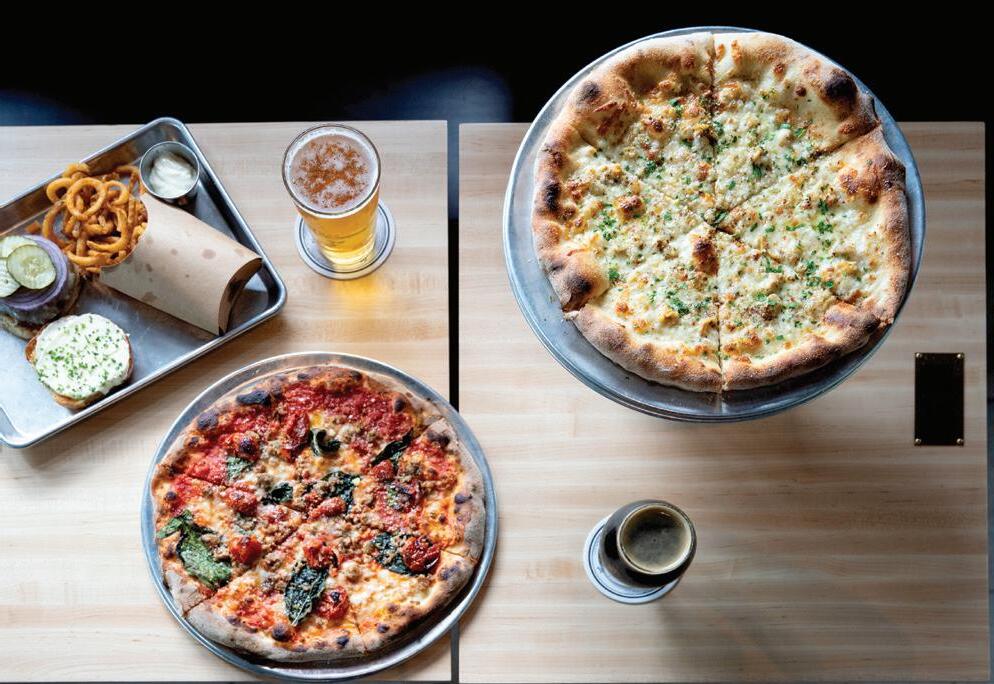
Pepperoni and Pilsners
Chef Jeff Seizer is driving a creative vision for Ponysaurus’s new location in Raleigh Iron Works.
BY NATION HAHN food @indyweek.com
J
eff Seizer spent much of his career in fine dining, but his first culinary idols were the cooks at the pizza shop in his childhood Brooklyn neighborhood.
“They were like the coolest dudes in the world,” Seizer recounts. “The shop had this old-school Italian vibe. Everyone knew the pizza guys. They drove cool cars, and I looked up to those guys growing up.”
It is fitting, then, that Seizer now helms the pizza kitchen for Ponysaurus Brewing at the company’s recently opened Raleigh Iron Works space, its third location. Leading a pizza kitchen, he says, is the culmination of a 22-yearlong dream.
Seizer has spent his entire career in kitchens, beginning with cooking school at age 18. His first kitchen job was at Montrachet, the illustrious French restaurant in New York City that closed in the early 2000s. He was part of a six-person intern class—and was the only intern to last the summer.
“All I did at that job for six months was make blinis with caviar. I just stood there with a little hot plate and flipped blinis,” Seizer remembers, laughing.
From there, Seizer moved on to Union Square Cafe, where he began as a line cook before assuming the role of sous chef. Union Square Cafe brought him fully into the hospitality company of legendary restaurateur and chef Danny Meyer. Seizer went on to join Maialino’s opening team, eventually serving as the chef de cuisine of the Gramercy Park Hotel restaurant. While leading the kitchen there, he cooked for the likes of Keith Richards, Mick Jagger, and Questlove.
“I am this little kid from Brooklyn,” Seizer says of his fine-dining experience. “I am earning nothing, working my butt off, and I’m doing dinner for Questlove.”
Seizer cites Union Square Cafe’s Carmen Quagliata as one of his most important mentors. He points to Quagliata’s vision of putting beautiful ingredients on a plate with-
out overly complicating them as a key lesson in his own evolution as a chef, describing that ethos as cooking with “Italian sensibilities” in terms of believing that olive oil, garlic, roasting, and caramelization can drive a beautiful dish forward.
“You let time and heat do the work,” he says. “You develop the natural flavors.”
Ifirst met Seizer when he was guiding the kitchen at the now-closed Royale in downtown Raleigh. Seizer moved to the Triangle with his then wife to be closer to family. Royale offered a blend of French and American fare, including a much-loved burger that arrived on a locally made English muffin with Gruyère cheese and Royale sauce; fried duck wings made à l’orange; and moules frites. Some of my fondest memories of Royale’s food came when Jeff would offer one-night tasting menus. On several occasions, the menus were built around “red-sauce Italian” fare—and you could see his love for his grandmother’s cooking shine through. Even then, he would hint that an Italian restaurant might be in his future.
Royale, like many restaurants, fell victim to COVID-19, and Seizer found his way to the Counting House restaurant at Durham’s 21c Museum Hotel. He breathed new life into the menu there with, among others, a Royale burger and an array of pastas that often stole the show.
Shortly after he moved to Durham, Seizer befriended Nick Hawthorne-Johnson, one of the owners of Ponysaurus Brewing. They stayed in touch over the years, and one day Hawthorne-Johnson texted Seizer and asked him to chat. After learning that Hawthorne-Johnson’s next project would be based in Raleigh under the Ponysaurus brand— and that in this role Seizer would work with Anthony Guerra of Oakwood Pizza Box and that Seizer’s partner (in both life and the kitchen), Roxy Garcia, could join him in the kitchen—it was an easy yes for Seizer.
Ponysaurus launched as a Durham pop-up in the years before it became a full-fledged brewery in 2015. The brand felt creative from the start. From the pony-meets-dinosaur
10 May 29, 2024 INDYweek.com The INDY FOOD Is su e
(From left) The Classic Burger, the Blistered Tomato Pie, and the Clam Pie
PHOTO BY ANGELICA EDWARDS
logo to the slogan (“The beer beer would drink if beer drank beer”), the brand has showcased its creativity, as if it had been made to both delight and reflect the community in which it was built—and brewed.
I caught up with Hawthorne-Johnson recently about Ponysaurus’s expansion from Durham to Wilmington and now Raleigh. Hawthorne-Johnson said it ultimately came down to allowing Ponysaurus to do what it does best in more places: “We do two things,” he says. “We make beer and we hold space for people to gather together and build their community in our space. Opening some more locations where people can get together and where we can provide space for people to enjoy our beers and share in fellowship together was exciting.”
Over the past two years, the Ponysaurus team evaluated markets across North Carolina before settling on Wilmington and Raleigh. Both of the new Ponysaurus locations have opened within the last four months.
“With Raleigh, it came down to the fact that we have amazing friends doing really amazing things in the food and beverage space,” Hawthorne-Johnson says. “We wanted to come and add to the scene here and participate in all that is happening.”
The location’s proximity to the original brewery in Durham will also allow Ponysaurus’s production team to dive into making sours and barrel aging at the Raleigh facility while remaining close to their main brewing facility.
The proximity also means that many Raleigh customers have already visited the brewery in Durham. This comes with a cer-
tain amount of pressure, Hawthorne-Johnson adds: “It’s scary to open something that’s so close to our original location. Pretty much everybody here knows who we are and what we’re doing in Durham. We’re going to have a certain set of expectations.”
Over the past several months, Seizer, Garcia, and their team have worked to breathe life into the Raleigh location’s menu. The pizza is built around the sauce and dough that Guerra and Oakwood Pizza Box have perfected. Seizer and his team wanted to lean into “good, humble food” that reflects both the flavors that Seizer grew up loving and the seasonal bounty of the nearby farmers market.
On the current menu, you’ll find a clam pizza inspired by Seizer’s love for Frank Pepe Pizzeria in New Haven, Connecticut. It’s built on a white-sauce base, and the chopped clams taste fresh and swim in garlic, lemon, and parsley. You’ll notice just a little spiciness in the zest—and you’ll definitely want more than one slice.
You will also find a blistered-tomato pizza (that has, over repeat visits, become one of my favorites); wings that Seizer says are “cooked with minimal ingredients,” including a little brown butter and sugar; a burger made with LaFrieda beef and aged cheddar; and several salads. And, of course, there’s a pepperoni pizza, because as Seizer notes, “pepperoni and pilsners go super well together.”
Ultimately, pizza will remain core to the menu, even as the team works on varied options to go alongside it.
“Pizza and beer,” Seizer says, “are natural friends.” W
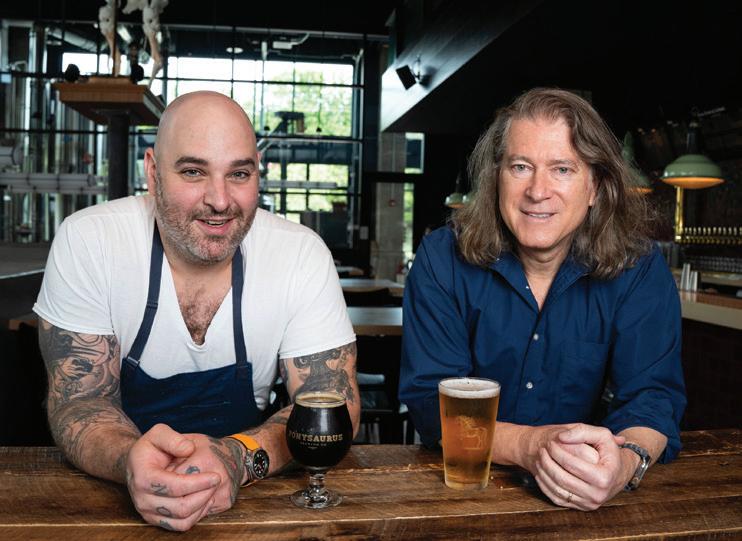

INDYweek.com May 29, 2024 11 Call 844-515-0862 to schedule your free quote!
Ponysaurus chef Jeff Seizer (left) and cofounder David Baldwin
PHOTO BY ANGELICA EDWARDS
The INDY FOOD Is su e
No Reservations
With the closure of the Raleigh location of Cheeni, Preeti Waas is going all in on creating the inviting Durham space she’s always dreamed about.
BY LAYLA KHOURY-HANOLD food @indyweek.com
When Preeti Waas first introduced herself to me at a hospitality industry event in November 2019, she said, “I brought you something,” and pressed a silver thermos into my hands. I unscrewed the lid and a current of steamy chai wafted upward, redolent of ginger, cardamom, and fennel. I took a sip and the hot, velvety tea slid down my throat like liquid comfort.
It remains one of the most touching gestures I’ve received as a food writer, but it’s exemplary of the thoughtful, personal touches that Waas extends to diners at Cheeni, too. Now, on the heels of closing her North Raleigh location, Waas is going all in on Cheeni Durham with her most personal menu to date and an expanded vision for community cooking classes, collaborations, and pop-ups.
On May 17, Waas also opened the Bar Beej, a “semisecret speakeasy” within Cheeni Durham.
“In Sanskrit, there is the beej mantra, a very powerful mantra that speaks to the divine feminine,” she says.
Waas speaks reverently about India’s origins as a matriarchal society, one at odds with the societal framework for women she grew up in: “A culture where you’re dried up after 40.” She describes operating Cheeni as a “bonus life past 50.”
Prior to meeting Waas back in 2019, I knew of her through her superlative chocolate chip cookies and juicy jams—a friend had gifted me samples from Sugar & Spice Kitchen and Jolly Good Jams, Waas’s two small-batch food companies. That fall, Waas had just opened Cheeni, an Indian tea and snack shop in the lobby of Raleigh’s Poyner YMCA.
The venture’s success propelled her to take another leap
May 29, 2024 INDYweek.com

forward, and in 2021 Waas opened Cheeni Indian Food Emporium in a North Raleigh shopping center. To honor her dream of teaching cooking classes, she had to become a full-fledged restaurant to obtain the proper permits. So in addition to serving pastries and chai, she added a counter-service menu: rice bowls and kebab rolls by day, lamb vindaloo and Bengali roast chicken by night.
Opening a restaurant led to one of Waas’s biggest surprises: being nominated as a James Beard Award semifinalist for Best Chef: Southeast in 2023 and 2024. The first nomination, in 2023, led to an influx of diners, but with high rent and a no-tipping model that starts all staff at a pay rate of $16 per hour, that boon didn’t translate into more profit. Focusing on her fledgling restaurant operation precluded her from allocating time and resources to cooking classes and guest chef pop-ups. When the opportunity came along in November 2023 to open Cheeni Durham in the former Jack Tar space in downtown Durham, her time became even further divided.
Once she got Cheeni Durham up and running, Waas planned to return Cheeni Indian Food Emporium to its original vision: a community space and marketplace for classes, events, pop-ups, and grab-and-go goods. But in mid-April, she received an unexpected call from her landlord detailing plans to sell the shopping center to an out-of-state entity. This, Waas says, “meant that the community aspect of the location, which is what appealed to me when I signed the lease, was no longer the case.”
She adds that “high rent and high operating costs without the sales to sustain them don’t work—especially when an impersonal entity owns the building.” On April 20, she
closed Cheeni Indian Food Emporium for good. Classes and events scheduled prior to the Raleigh location’s closure will be honored at Cheeni Durham, including a pop-up that morphed into a Mother’s Day brunch collaboration with Madre executive chef Luis Zouain. Cheeni Durham is closed on Wednesdays and closed on Sundays post-brunch, so during those times Waas envisions hosting cooking classes devoted to making chai, chutneys and chaats, and samosas and pakoras. She also plans to do popups with guests like Lauren Markowitz and Alex Fiacchi, formerly of A Mano in Syracuse, New York (slated for June 19), and Lordfer Lalicon, chef at Filipino restaurant Kaya, a James Beard Award finalist based in Orlando, Florida.
“I feel like I’ve come into my own and I’m realizing what ‘my own’ meant. I now know what is possible, what I’m capable of,” Waas says of creating Cheeni’s current spring-summer menu. “I’m able to take homemade ‘basic food’ and make it look appealing on the plate, and the flavors are fresh and true to me, not fussy at all, but I still make it look like ‘refined dining’—that’s what I call Cheeni Durham.”
Honoring her preferred flavor profiles—funk, acidity, balanced spice—while also meeting diners’ expectations has been a delicate balancing act for Waas. Servers at Cheeni Durham wear buttons that say, ‘Ask me about anything except chicken tikka masala,’ but Waas has found a workaround of sorts. Saunf wala chicken, the one dish her mother taught her to make, features tender chicken thighs cooked with fennel seeds, onions, and green chilies, plus Waas’s addition of tomatoes, and finished with whipped yogurt.
“It’s bright, it’s acidic, and it is not a creamy dish where
12
Preeti Waas, the owner and chef of Cheeni, speaks to customers while they finish a meal. PHOTO BY ANGELICA EDWARDS
it has cream, which is what people think of when they think of tikka masala,” Waas says. “We don’t cook like that in India or eat like that in India, at least not how I grew up.”
Waas was born and raised in the south of India, but she identifies with her Punjabi heritage. After the partition of India and Pakistan, Waas’s father moved from northern India to the state of Tamil Nadu on the southeast coastline.
“We lived like Punjabis at home, so we ate like Punjabis every day,” Waas says. For Waas and her siblings, a typical Punjabi lunch consisted of whole-wheat roti (unleavened flatbread) served with dal (lentils) and accompaniments such as raita (a yogurt-vegetable sauce), and sabzis (vegetable sides). Waas pays homage to her
of Waas’s favorite creations is fish moilee, which highlights a Keralan coconut curry sauce. She bucked tradition by blending the sauce and was delighted to discover that it further concentrated its ingredients’ flavors, including garlic, ginger, and chilies. Mild, buttery barramundi is marinated in lemon juice, turmeric, and salt, then seared skin-side down for a contrasting crisp. Two pieces are arranged skin-side up in an oval bowl, briefly luxuriating in the silky, bright yellow coconut sauce before being anointed with a verdant green curry leaf oil.
“I love it so much. I have chefs clamoring for this dish,” Waas says. “It’s a dish that makes people want to lick their fingers.”
Happily, it’s served with flaky, crispy Malabar parathas to mop up the luscious sauce.
Another Kerala-inspired favorite are the
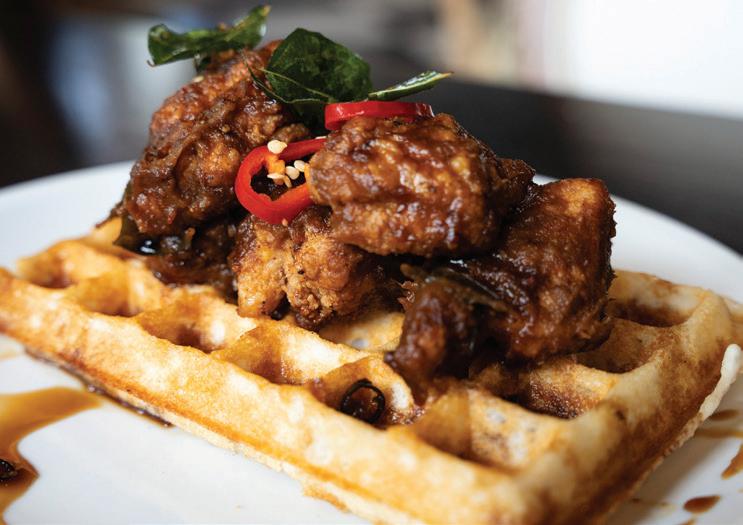
Punjabi roots with tamatar and bhindi daal tadka, slow-cooked split chickpea lentils with tomatoes and okra, tempered with ghee and panch phoran, a five-spice blend of black mustard, cumin, fennel, nigella, and fenugreek seeds. “It’s a seed blend that combines north, south, east, and west so well; it symbolizes India to me,” Waas says.
Waas’s expansive view of Indian cuisine is reflected on her menu, which draws inspiration from culinary traditions all across the country. On the printed menu, you’ll find outlines of various states denoting a dish’s speculated origins alongside anecdotes of Waas’s connections to and riffs on each dish.
Growing up in a coastal town fostered Waas’s love of seafood and an appreciation for both coasts’ preparation styles. One

muttakos medallions, inspired by vegetable poriyal, described on Cheeni’s menu as “a simple, tasty accompaniment to many meals, often prepared with freshly grated coconut, tempered curry leaves, and mustard seeds.” Waas’s interpretation makes fresh cabbage the main event by cutting it into “steaks,” which are then brined and braised until silky. The medallions are then charred on the flat top, plated atop a limepickle-spiked yogurt sauce, and finished with a tarka of fresh ginger, green chili, and black mustard seeds tempered in oil.
“It’s not me just opening a restaurant of Indian origin and saying I’m going to sell Indian food,” Waas says of her evolution as a chef. “This is a journey for me. It is a journey of saying, ‘I’m exploring what it means to be me through my food.’” W


INDYweek.com May 29, 2024 13
The Chettinad-style chicken and dosa waffle on the brunch menu at Cheeni features masala-coated fried chicken placed on a dosa waffle with chili-jaggery syrup. PHOTO BY ANGELICA EDWARDS
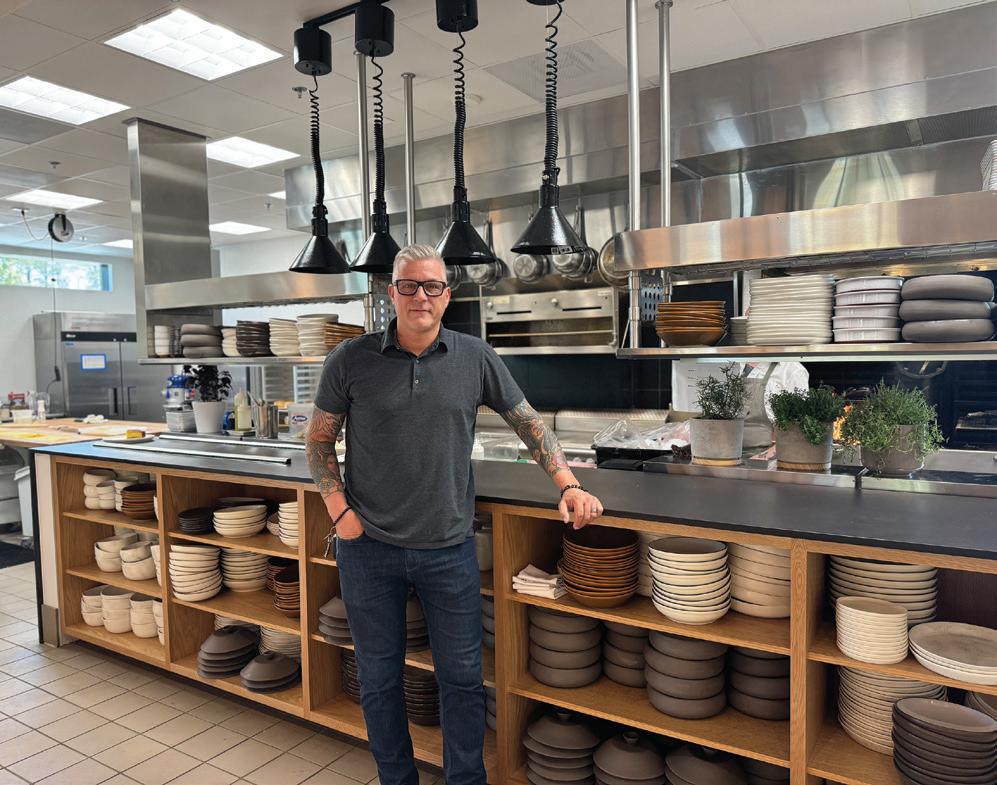
Bright Days Ahead
With the recent openings of restaurant Brodeto and bar Sous Terre, plus several more concepts to come, chef Scott Crawford has forged a path forward out of the dark pandemic years.
BY NATION HAHN food @indyweek.com
The sun is beaming into Brodeto’s dining room a few hours before service begins. I’m sitting with chef Scott Crawford, discussing the evolution of his vision for his restaurant group over café Americanos. He’s reflecting on the early months of the COVID-19 pandemic.
“I almost immediately went to a dark place in my mind, because that’s what addicts do, right?” he says. “My career’s over, our restaurants are shut down, people are dying. It’s a dark time for everyone, but mentally, I knew that I was in trouble.”
Crawford acknowledges that his thinking shifted as time passed, but for his own mental health at the time he had to find a way to embrace his creativity and work ethic in an effort to find a new path forward.
The pandemic upended the entire restaurant industry, and the changes persisted even as the pandemic reced-
ed. The increased adoption of working from home has reshaped how some restaurants approach lunch, if they open for it at all. Countless restaurants have closed or transitioned to other models, such as food trucks.
Against this backdrop, Crawford Hospitality stands out as one of the most ambitious restaurant groups in the Triangle with Brodeto’s recent opening at Raleigh Iron Works and the group’s new cocktail bar, Sous Terre, which opened in mid-May. Crawford Genuine will soon open at RaleighDurham International Airport, and Crawford Brothers Steakhouse, initially announced in 2018, has a planned opening for later this year.
Still, all of this growth began in a dark place.
Throughout his years in recovery, Crawford says he realized he has to have a continual focus on his mental health in order to remain strong for himself and his family and to
serve as a good leader for his company. To step out of the dark place, he knew that he had to get to work. During the pandemic, his neighborhood restaurant Crawford & Son began offering takeout, French bistro Jolie offered a variety of creative activations including a champagne window, and the community’s support of both concepts gave Crawford hope.
“I started planning. I started saying, ‘I know this is going to change, this is going to end,’ and asking what will I do then,” Crawford says.
When he left his restaurants each day, he kept his mind busy imagining what other concepts he might launch. Serendipitously, his phone began to ring as talented service industry professionals who worked for some of the top hospitality companies in the country realized they could move to a market like Raleigh for a lifestyle change.
Between the concepts that Crawford spent his evenings drawing up, the talent that his team was adding, and the pandemic receding with the rollout of vaccinations, the Crawford Hospitality team was ready to make those dreams a reality.
Brodeto is the first of the new restaurants to come to life. When visitors step inside the restaurant, they find the bright, airy space that takes inspiration from the Crawford family’s travels to the Croatian and Italian coasts along the Adriatic Sea.
The bar resembles the salt blocks they discovered in markets at the Italian coastal villages they toured, and it is backlit to suggest the feel of the sea. A lattice-like wall next to the host stand draws inspiration from the fences surrounding the backyards of residences in the towns Crawford and his family walked through. Along the wall is a Thomas Sayre–designed piece that represents the Adriatic coastlines.
The food at Brodeto similarly represents a unique fusion of the flavors and approaches Crawford discovered on his first visit to Croatia. Crawford and his team have found ways to fuse the dishes and approaches he saw on his travels with North Carolina ingredients. The restaurant’s name is an homage to brodetto—what locals call the fish stews found along the Adriatic coast. The base concept for any brodetto is to use a wide array of fish, and at Crawford’s Brodeto you’ll find monkfish, prawns, and octopus. But you’ll also find wild mussels and clams harvested along the coast of North Carolina by a purveyor Scott knows.
Several other offerings tap into this combination of familiar dishes, nostalgia, and coastal influence.
The spaghetti al nero, little gem hearts, and agnolotti were some of my favorites during my first two visits. The sea urchin butter and chili pangrattato in the spaghetti dish
14 May 29, 2024 INDYweek.com The INDY FOOD Is su e
Chef Scott Crawford photographed at Brodeto PHOTO BY NATION HAHN
provide a nice touch of heat and richness. The ramp Caesar in the little gem hearts brings a delightful punch to an old favorite.
The agnolotti combines the pasta’s typical light, pillowy texture with sweet peas and lemon zest.
The menu at Brodeto is larger than those at Crawford’s earlier restaurants, and the hope is that it will allow diners to work their way through it with friends on subsequent visits.
Along the Person Street corridor two miles south of Raleigh Iron Works, where Crawford launched Crawford Hospitality, you’ll find Sous Terre. Crawford and his longtime mixologist Jordan Joseph evaluated various locations around town for a potential home for a bar that would focus on classic cocktails and high-quality hospitality. The answer, ultimately, arrived just down a flight of stairs from Jolie when Atlantic Lounge owner Jason Howard called Crawford and offered him the chance to take over the space.
Crawford and Joseph jumped at the opportunity to build the cocktail bar in a neighborhood that feels like home to them both.
“We want it to feel like a warm hug,” Crawford says of the way he wants guests to experience Sous Terre.
I am struck by the bar’s clean lines and warm wood. The space still has the cozy, neighborhood-bar vibe of the Atlantic Lounge, but it is brighter and lighter. The overhaul began in January and was a true family effort for all involved: Crawford and his wife, Jessica, worked on design elements,
while Joseph’s stepdad and brother and a family friend cleaned the place and led much of the remodeling, down to laying the tile.
“We want a particular feel here. We keep coming back to the word ‘cozy.’ We want this to be a place where you can kind of get lost in,” says Joseph. “When you enter this cozy atmosphere, you’ll find the perfect lighting, the right mix of people and drinks, and great music—music that’s pretty damn loud, too.”
The menu at launch is small, part of what Joseph describes as an “evolutionary process” for the bar. But Joseph’s team has spent time thinking through every aspect of the cocktails. For example, they use Plymouth Gin for their martinis, and the gin comes directly from the freezer for each cocktail. They tested variations of a Sazerac before deciding to pre-batch it, because they prefer the flavor that comes through as the batch develops.
In time, the menu will evolve toward cocktails that include a host of techniques, including fat washing, in which alcohol is infused with something oily for extra flavor. Joseph promises to find ways to use Jolie’s grill to bring elements to the cocktails and plans to offer throwback bottles. One day you’ll be able to walk in and sip on a glass of 1972 Fernet-Branca, for example.
Crawford says hospitality is the one through line that he hopes connects all of his various concepts.
“Hospitality encompasses the cooking, the crafting of the cocktails, the knowledge of the wine,” he says, “and the way people make you feel when they’re serving you.” W
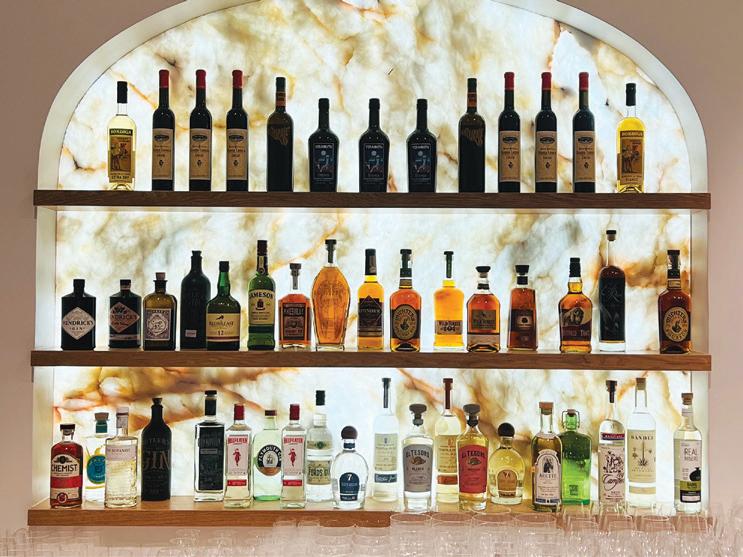

INDYweek.com May 29, 2024 15
The bar at Brodeto PHOTO BY NATION HAHN
The INDY FOOD Is su e
Fridge Study
We asked five Triangle chefs, restaurateurs, farmers, and small purveyors what they keep in their refrigerators at home.
BY LENA GELLER lgeller@indyweek.com
TORIANO FREDERICKS
Chef/owner of Boricua Soul
Can you list some things that are in your refrigerator right now?
FREDERICKS:
• A general-style red sauce, because our son eats that every day for lunch. We put chicken tenders in the air fryer and put that sauce on them.
• Cherry pepper hoagie spread.
• Sweet chili sauce.
• Provolone cheese.
• Soul Slapping Seasoning. That’s our signature seasoning that we put on pretty much everything.
• Deli meats: salami, prosciutto, soppressata.
• Cucumbers. I love cucumbers. [My wife] Serena can’t stand them.
• Some salad ingredients: bacon crumbles, blue cheese, McIntosh apples, cider vinaigrette. We went to Il Palio in Chapel Hill for our anniversary, and Serena ate a salad there that she’s been obsessed with, so those ingredients are to try to recreate it.
• Mayonnaise—and if you want to cause a controversy …
Is it not Duke’s?
It’s not Duke’s [laughs].
This might be a bigger story than I realized.
Look, my grandmother is from Georgia, and she’s always used Hellmann’s.
Out of all the times you open your fridge, what do you reach for most often and what do you do with it?
That’s a hard question. I’m not sure. I open the refrigerator a lot out of boredom, so if I’m doing that, normally I’ll grab a piece of deli meat and a piece of provolone and just roll it up and eat it. We’ve been adding that pepper spread to anything and everything—tacos, a salad, just dropping it on there. And I’m almost always cooking with the Soul Slapping Seasoning: I’ll put it on grilled meat, like chicken or pork chops.
I’m gonna run through a list of foods that some people refrigerate and some people don’t, and you tell me your stance. Bread? No, because we go through it so quickly.
Eggs? Yes.
Ketchup?
Yes and no. I put it in, Serena takes it out. I think it’s just a household thing. If you grew

up in a household where you put it in the fridge, that’s what you do. And if you didn’t, you’re like, “Why are you doing this?!”
Peanut butter?
Absolutely not.
Tomatoes?
I had been putting them in the refrigerator, but I think I’m actually going to go back to storing them at room temperature, because I was watching Produce Pete the other day—do you know who Produce Pete is?
I do not.
My wife and I were both born and raised in the Northeast, so we actually grew up watching the same news station. I grew up in Connecticut, and she grew up in New York. We both watched New York news. Recently, she found a New York news station on the Fire Stick, so every morning, she’s been put-
ting it on, and there’s a segment on there with a guy called Produce Pete. He’s an old Italian guy and he sits in his apartment and talks about different produce and where it comes from and how to store it. Produce Pete was talking about tomatoes the other day, and he was like, “You really shouldn’t store your tomatoes in the refrigerator.”
Can you your refrigerator
Is there anything you eat cold out of the fridge without heating up?
I eat leftovers without warming them up. My son thinks this is the funniest thing. He’ll make the announcement: “Mom, Dad’s eating cold stuff out of the refrigerator again.”
Is there anything in your fridge that’s expired right now?
Maybe some vanilla yogurt. Here’s why. We have good intentions. We’re like, “We’re gonna go hard on smoothies this week.” And then we kinda don’t.
• I always on me,
• Three to paste.
• A tube that I Hill. I
• A big
• Brown
• Chicken
• Salted on a trip
16 May 29, 2024 INDYweek.com
Th
The fridge of Toriano and Serena Fredericks, the owners of Boricua Soul PHOTO BY ANGELICA EDWARDS
TORGERSON:
Founder
TORGERSON
The INDY FOOD Is su e

ERIN
ERIN
TORGERSON
TORGERSON
Founder of Seeds & Salt and farmer at Red’s Quality Acre
Founder of Seeds & Salt and farmer at Red’s Quality Acre
Can you list some things that are in your refrigerator right now?
Can you list some things that are in your refrigerator right now?
TORGERSON:
TORGERSON:
• I always keep quite a few anchovies on me, either salt-packed or in a tube.
• I always keep quite a few anchovies on me, either salt-packed or in a tube.
• Three equally used-up tubes of tomato paste.
• Three equally used-up tubes of tomato paste.
• A tube of Hungarian red pepper paste that I got from Mariakakis in Chapel Hill. I love tubes.
• A tube of Hungarian red pepper paste that I got from Mariakakis in Chapel Hill. I love tubes.
• A big thing of salsa macha that I made.
• A big thing of salsa macha that I made.
• Brown Cow yogurt, plain.
• Brown Cow yogurt, plain.
• Chicken stock.
• Chicken stock.
• Salted cod that my brother got for me on a trip to Iceland.
• Salted cod that my brother got for me on a trip to Iceland.
• Miso.
• Miso.
• Tahini.
• Tahini.
• I recently discovered Colman’s Mustard. It’s really spicy but it’s really good.
• I recently discovered Colman’s Mustard. It’s really spicy but it’s really good.
• A variety of pickles that I’ve made: classic cucumber pickles, pickled cauliflower, pickled piquillo peppers, pickled onions.
• A variety of pickles that I’ve made: classic cucumber pickles, pickled cauliflower, pickled piquillo peppers, pickled onions.
• Pears preserved in sweet wine syrup with some spices.
• Pears preserved in sweet wine syrup with some spices.
• Buttermilk. When I have expired milk, I just add it to my buttermilk container.
• Buttermilk. When I have expired milk, I just add it to my buttermilk container.
• Chicken fat and pork fat that I’ve rendered down. The chicken fat is really good on roasted vegetables.
• Chicken fat and pork fat that I’ve rendered down. The chicken fat is really good on roasted vegetables.
• I have a few jars of peach-pit vinegar. My friend taught me this trick: after you eat a peach, drop the pit in a jar of white wine vinegar, and it makes a really tasty vinegar that you can use for salad dressings.
• I have a few jars of peach-pit vinegar. My friend taught me this trick: after you eat a peach, drop the pit in a jar of white wine vinegar, and it makes a really tasty vinegar that you can use for salad dressings.
Do you have mayo?
Do you have mayo?
Oh yeah, Duke’s forever.
Oh yeah, Duke’s forever.
Out of all the times you open your fridge, what do you reach for most often and what do you do with it?
Out of all the times you open your fridge, what do you reach for most often and what do you do with it?
I eat a Brown Cow yogurt every day. I use buttermilk quite a bit, for pancakes and things. And I use anchovies a lot.
I eat a Brown Cow yogurt every day. I use buttermilk quite a bit, for pancakes and things. And I use anchovies a lot.
What do you usually do with anchovies?
What do you usually do with anchovies?
I just chop them up and add them to different things like salad dressing or pasta sauce.
I just chop them up and add them to different things like salad dressing or pasta sauce.
I’m gonna run through a list of foods that some people refrigerate and some people don’t, and you tell me your stance. Bread?
I’m gonna run through a list of foods that some people refrigerate and some people don’t, and you tell me your stance. Bread?
I really don’t like refrigerating bread, but it keeps it better for longer. I prefer to freeze it; it stays much fresher.
I really don’t like refrigerating bread, but it keeps it better for longer. I prefer to freeze it; it stays much fresher.
Eggs?
Eggs?
I do refrigerate eggs. What I’ve been told as a farmer is that they’re only shelf-stable if they’re fresh out of the chicken. Once they’ve been washed, they lose a protective microbiome.
I do refrigerate eggs. What I’ve been told as a farmer is that they’re only shelf-stable if they’re fresh out of the chicken. Once they’ve been washed, they lose a protective microbiome.
Ketchup?
Ketchup?
I don’t like ketchup.
I don’t like ketchup.
Peanut butter?
Peanut butter?
Not in the fridge.
Not in the fridge.
Tomatoes?
Tomatoes?
No, definitely not. Technically, from a farmer’s perspective, we refrigerate tomatoes when we harvest them, but they can’t be any colder than 55 degrees.
No, definitely not. Technically, from a farmer’s perspective, we refrigerate tomatoes when we harvest them, but they can’t be any colder than 55 degrees.
Is there anything you eat cold out of the fridge without heating up?
No, not really. Unless it’s desperate measures. I did eat some cold chicken the other day.
Is there anything you eat cold out of the fridge without heating up? No, not really. Unless it’s desperate measures. I did eat some cold chicken the other day.
Is there anything in your fridge that’s expired right now?
Is there anything in your fridge that’s expired right now?
I got a Costco membership and I bought this crab dip, and I think I just got overwhelmed by it. The first three bites, I was like, “This is good,” and then I was like, “OK, I don’t need this.” So that’s gone bad.
I got a Costco membership and I bought this crab dip, and I think I just got overwhelmed by it. The first three bites, I was like, “This is good,” and then I was like, “OK, I don’t need this.” So that’s gone bad.
INDYweek.com May 29, 2024 17
The fridge of Erin Torgerson, a farmer at Red’s Quality Acre and the founder of Seeds & Salt Pasta Pop-Up PHOTO BY ANGELICA EDWARDS
The fridge of Erin Torgerson, a farmer at Red’s Quality Acre and the founder of Seeds & Salt Pasta Pop-Up PHOTO BY ANGELICA EDWARDS

BILL SMITH
Former Chef/owner of Crook’s Corner
So, you were in Mexico for five weeks and just got back a few days ago. How’s your fridge looking?
SMITH: I tried to get out as much as I could before I left. A friend of mine was staying here, but he didn’t use much of anything. The one thing that I was able to make when I got back: I had two eggs and about a half stick of rancid butter and country ham and some odd pieces of cheese, so I made a big wheel of corn bread out of that.
Can you list some other items you’ve got in the fridge?
• Half of what’s in here is jelly and cordials and pickles that people have given me. Most of it is in the back. I see a jar of figs in brandy that someone gave me for Christmas and some pickled jalapeños.
• Collards and cauliflower that I got at the farmers market this morning.
• I’ve always got beer, of course.
• A little piece of country ham hock that I got from Cliff’s. I live alone, so I never want a whole ham hock, but you can get it in chunks at Cliff’s, which is handy.
• Bacon from Cliff’s.
• Cheese: regular goat cheese from Celebrity Dairy and Calvander and Danziger from Chapel Hill Creamery.
• Buttermilk.
• There’s this great brand of salad dressing they have at Weaver Street Market called BRIANNAS. I’d never heard of it until lately. I have their ranch dressing.
• Membrillo, which is a quince paste that I learned about in Spain years ago. It’s really good with cheese.
• Peas soaking to be cooked later on.
• Several bottles of Prosecco.
• Rosé.
• Honey wine from Quebec.
Do you have mayo?
I don’t have mayo right now.
When you do have it, is it typically a certain brand?
I don’t get in the mayonnaise fight. There are too-big problems in the world to fight about mayonnaise.
I will tell you, one of the kids who used to work for me had a fight with his father and he was living in his car, so I let him come live at my house for a while—he slept

on my couch—and he started buying this mayonnaise that’s made with lime juice, McCormick Mayonesa. So I buy it now when I go to the Latino grocery store down the street from me.
My great-grandmother always used Hellmann’s and made a big point of pointing out that she did. She was an old lady from Eastern North Carolina. I’ve wondered why she made such a big deal about it, and the only thing I can figure is that during the Great Depression they pretty much lost everything but they had pretense still, and I think Hellmann’s was a little bit more expensive and they could brag that they’d spent that extra 10¢ or whatever to have the fancier mayonnaise. She always called it by name.
Out of all the times you open your fridge, what do you reach for most often and what do you do with it?
I do not cook very much here. Bacon, beer, and butter are my three favorite foods, so those are the things I’ll be reaching for, if anything.
I’m gonna run through a list of foods that some people refrigerate and some people don’t, and you tell me your stance. Bread?
Corn bread, but not bread. I never refrigerate bread. I’ve got some in a bread box on my counter.
Eggs?
I don’t like eggs. I do keep ’em around if I’m making stuff.
And you keep them in the fridge when you have them on hand?
Yes. Although I know people who don’t. When I was growing up, nobody did.
Peanut butter?
Not in the fridge.
Tomatoes?
No. You never refrigerate tomatoes. Never, never, never. You ruin ’em. Once you slice them, you have to. But never ever refrigerate whole tomatoes.
Is there anything you eat cold out of the fridge without heating up?
I love cold spaghetti. I also love cold collards. And I love cold barbecue on a slice of raw onion. When I was at Crook’s Corner, that was one of my favorite late-night snacks. I would get a slice of onion that would’ve gone on a hamburger and pile barbecue on top of it.
Is there anything in your fridge that’s expired right now?
I have cherry vanilla bitters from a food festival I went to a very long time ago. I don’t know if it’s poisonous yet. It’s one of those things that just sits in the door.
18 May 29, 2024 INDYweek.com
The fridge of Bill Smith, the retired chef who spent decades at Crook’s Corner PHOTO BY ANGELICA EDWARDS
The INDY FOOD Is su e
Out of all the times you open your fridge, what do you reach for most often and what do you do with it?
I eat a Brown Cow yogurt every day. I use buttermilk quite a bit, for pancakes and things. And I use anchovies a lot.
What do you usually do with anchovies?
I just chop them up and add them to different things like salad dressing or pasta sauce.
I’m gonna run through a list of foods that some people refrigerate and some people don’t, and you tell me your stance. Bread?
I really don’t like refrigerating bread, but it keeps it better for longer. I prefer to freeze it; it stays much fresher.
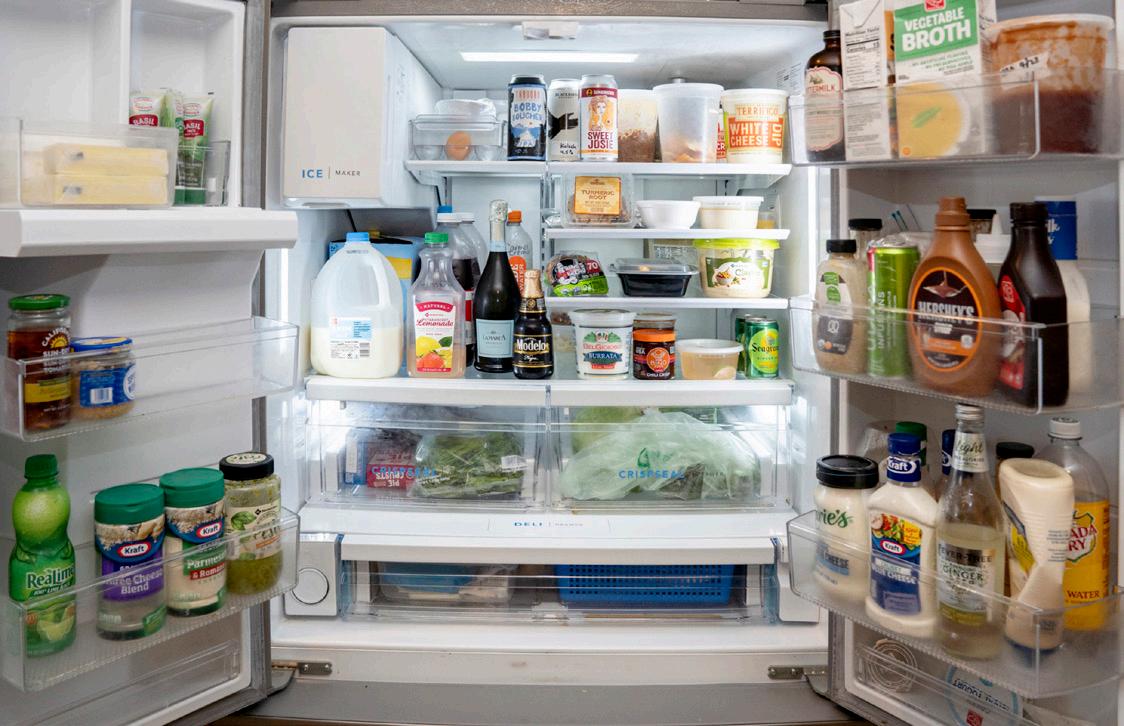
Eggs?
HARRY MONDS
Chef/owner at Lula & Sadie’s
ERIN TORGERSON
Can you list off some things that are in your refrigerator right now?
MONDS:
Founder of Seeds & Salt and farmer at Red’s Quality Acre
• Skim milk.
• Prosecco.
• Turmeric root.
Can you list some things that are in your refrigerator right now?
• Hummus.
• Basil pesto.
• Apple-honey vinaigrette.
• Chocolate and caramel syrups.
• Sweet Carolina barbecue sauce.
• Miso.
• Tahini.
Do you have mayo? I do.
• I recently discovered Colman’s Mustard. It’s really spicy but it’s really good.
Is it Hellmann’s or Duke’s?
I’m gonna get killed for this. It’s Hellmann’s.
• A variety of pickles that I’ve made: classic cucumber pickles, pickled cauliflower, pickled piquillo peppers, pickled onions.
Out of all the times you open your fridge, what do you reach for most often and what do you do with it?
• Pears preserved in sweet wine syrup with some spices.
I do refrigerate eggs. What I’ve been told as a farmer is that they’re only shelf-stable if they’re fresh out of the chicken. Once they’ve been washed, they lose a protective microbiome.
her bread, which is some kind of organic bread that she likes. I don’t refrigerate mine.
Ketchup?
Eggs?
Yes.
I don’t like ketchup.
Peanut butter?
Ketchup?
Not in the fridge.
No. And I think you’re really weird if you do.
Tomatoes?
Peanut butter?
No.
TORGERSON:
• Chili crisp.
• Veggie broth.
• Burrata.
• Buttermilk. When I have expired milk, I just add it to my buttermilk container.
• Eggs.
• I always keep quite a few anchovies on me, either salt-packed or in a tube.
• Yeast.
• Chicken fat and pork fat that I’ve rendered down. The chicken fat is really good on roasted vegetables.
No, definitely not. Technically, from a farmer’s perspective, we refrigerate tomatoes when we harvest them, but they can’t be any colder than 55 degrees.
Tomatoes? No.
• Three equally used-up tubes of tomato paste.
• A bunch of craft beer.
• Stone-ground mustard.
• Sun-dried tomatoes.
• A tube of Hungarian red pepper paste that I got from Mariakakis in Chapel Hill. I love tubes.
I’m very odd. I drink a lot of milk. I literally drink a gallon every two days. Just regular skim milk. So either that, or, if it’s the end of the night I’ll grab a beer when I get home. Cooking-wise, I’ll grab basil pesto, feta cheese, and whip up a quick pasta dish with that.
• Cilantro paste.
• Ginger beer.
• A big thing of salsa macha that I made.
• I have a few jars of peach-pit vinegar. My friend taught me this trick: after you eat a peach, drop the pit in a jar of white wine vinegar, and it makes a really tasty vinegar that you can use for salad dressings.
Is there anything you eat cold out of the fridge without heating up?
Is there anything you eat cold out of the fridge without heating up?
No, not really. Unless it’s desperate measures. I did eat some cold chicken the other day.
It’s a rarity. I like hot food. Depending on how hungry I am, I may grab a slice of cold pizza.
• Limoncello.
• Brown Cow yogurt, plain.
• Broccolini.
• Chicken stock.
• Salted cod that my brother got for me on a trip to Iceland.
• Lamb chops that I’m cooking for dinner tonight.
Do you have mayo?
Oh yeah, Duke’s forever.
I’m gonna run through a list of foods that some people refrigerate and some people don’t, and you tell me your stance. You already mentioned eggs. How about bread? No. Well, it depends. My wife refrigerates
Is there anything in your fridge that’s expired right now?
Is there anything in your fridge that’s expired right now?
I don’t have anything store-bought that’s expired. But I did make some chili for a gathering … what’s the date on here … OK, I made it at the beginning of April, and it’s still in here.
I got a Costco membership and I bought this crab dip, and I think I just got overwhelmed by it. The first three bites, I was like, “This is good,” and then I was like, “OK, I don’t need this.” So that’s gone bad.
INDYweek.com May 29, 2024 19
The fridge of Harry Monds, the owner and executive chef at Lula & Sadie’s PHOTO BY ANGELICA EDWARDS
The fridge of Erin Torgerson, a farmer at Red’s Quality Acre and the founder of Seeds & Salt Pasta Pop-Up PHOTO BY ANGELICA EDWARDS
DEREK PIERCE
Chef at Hutchins Garage and founder of Savant Garde Provisions hot sauce
Can you list off some things that are in your refrigerator right now?
PIERCE:
• Almond milk.
• A bunch of different hot sauces.
• Chili crisp.
• Yuengling pilsner.
• Soda waters from Harris Teeter.
• Eggs.
• Ketchup.
• Coffee creamer.
• Bouillons.
• Hoisen sauce.
• Mustard—Maille.
• Garlic.
• Chick-fil-A sauce. That’s not mine. [It’s my wife’s.]
• Sour cream.
• Cheese: Swiss and cheddar.
• Sambal oelek, which is a chili paste.
• Gochujang, which is another chili paste.
• Bread.
• Tomato paste.
• Cilantro.
What kind of mayo do you have? Two kinds: Duke’s and Kewpie.
I’m gonna run through a list of foods that some people refrigerate and some people don’t, and you tell me your stance. I think you already said that you refrigerate ketchup and bread, which are two of the items. Yeah, I always keep the bread in the fridge. Ninety-nine out of 100 times I’m going to toast it, so it’s not going to be cold when I eat it.
Eggs?
Yes, definitely.
Peanut butter?
No. Do people keep peanut butter in the fridge?
Some people do, yeah. Huh.
How about tomatoes?
I don’t really keep a lot of fresh groceries because I’m two minutes away from a grocery store.
Out of all the times you open your fridge, what do you reach for most often and what do you do with it?
Most of the time it’s almond milk, for my coffee in the morning, or if it’s late at night, my favorite go-to snack is sour cream with some Savant [Garde] hot sauce and tortilla chips.
Walk me through the hot sauces you’ve got in the fridge.
I have sriracha, which I usually put on takeout Chinese because I like the sweetness with it. I have sambal oelek, although that’s not really a hot sauce, it’s a chili paste. If I’m eating dumplings, I’ll mix it with a little soy and sesame oil and use it as a dipping sauce. And I have Crystal. I like that with my eggs in the morning because it’s super bright and simple.
I also have all four of my Savant [Garde] hot sauces: Red Hot is like your table hot
sauce; Chile Verdant is a salsa verde; Maximus is barbecue-ish—it’s great for long roasts; and Halmi is like liquid kimchi, it’s gold.
Is there anything you eat cold out of the fridge without heating up?
All leftovers.
Is there anything in your fridge that’s expired right now?
I’ve got some aging eggnog in here. It’s purposefully aged. It’s a recipe I found on Instagram from a place in New York. It’s sugar, a bunch of alcohol, and eggs, and you age it for two years, and then when you make the cocktail, it’s whole milk, halfand-half, shaken and with some nutmeg on top. The egg batter itself is 18 percent, so supposedly it’s more safe the longer it sits, because the 18 percent will kill everything in the bottle. W
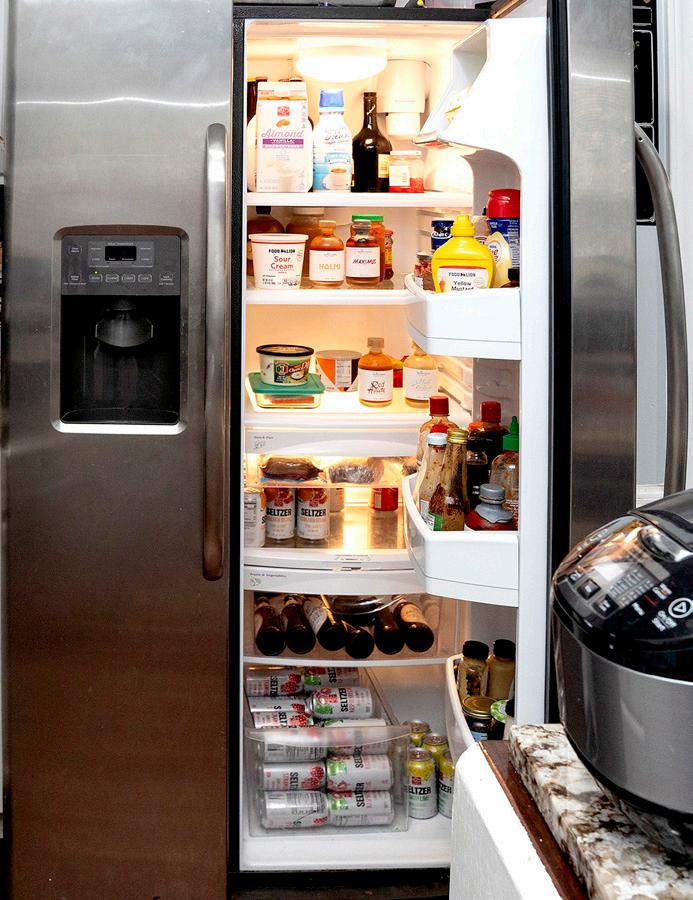
20 May 29, 2024 INDYweek.com
The fridge of Derek Pierce, the chef at Hutchins Garage and founder of Savant Garde Provisions hot sauce PHOTO BY ANGELICA EDWARDS
When a Window Is a Door
How Durham’s culinary entrepreneurs are navigating the hospitality industry’s challenging new landscape
BY JUSTIN LAIDLAW jlaidlaw @indyweek.com
For over a decade, food magazines, national news outlets, and social media influencers have showered Durham with praise for its culinary excellence. The tastiest town in the South offers a smorgasbord of delicious food that satisfies a wide range of palates. And as Durham’s population grows, so does its list of James Beard Award–winning chefs. But being a foodie destination was not always the city’s destiny. Many of Durham’s flagship restaurants came from humble beginnings.
Areli Barrera Grodski and Leon Grodski Barrera—owners of Little Waves Coffee, their own coffee roaster, and three brickand-mortar coffee shops in Durham under the name Cocoa Cinnamon—started their business from a bike cart they parked outside of Motorco and at the Durham Farmers Market back in 2011.
Pie Pushers, Boricua Soul, and the Parlour, fixtures of the downtown Durham food scene, all started as regular participants of the Food Truck Rodeo at Durham Central Park in the early 2000s before climbing the ladder (and a flight of stairs in Pie Pushers’ case) to permanent locales.
But as rents increase and competition grows, taking that leap of faith is harder for prospective food entrepreneurs. Inflation—which peaked in June 2022 at about 7.1 percent and has held steady at around 3 percent since then—continues to raise the cost of goods, and business owners who want to do right by their staff are raising wages, which increases payroll cost. What steps can entrepreneurs take to get creative in times of hardship, and will small businesses get the support they’re asking for from city leadership?
A window of opportunity
When Michelle Vanderwalker and Sean Umstead considered opening Queeny’s in 2021, they included designs for a small drive-thru-style window facing the sidewalk as a COVID pandemic precaution. The 12-by-12-foot space would allow them to offer to-go food and, thanks to a new state law, cocktails. But as in-person dining returned toward the end of that year, the need for Queeny’s to offer socially distanced sales subsided.
But closing the window opened a door for other burgeoning food entrepreneurs to fill the space.
Isaac Henrion started making bagels out of his home kitchen in 2021. He would pop up at the park near his house to sell them and build a customer base among his neighbors. After collaborating with Ideal’s sandwich shop on three pop-ups, Henrion caught Umstead’s attention.
“We didn’t have any experience, and we hadn’t fully determined what our ideas were,” Henrion says, “so this was an amazing opportunity for us to practice doing what we wanted to do in another space in a way that felt really low-risk. The space already existed and we didn’t have to put a bunch of money into it, and there was already exposure from having Queeny’s shining a light on us.”
The space is compact, and with no additional kitchen, Umstead says it’s best used as a retail location to serve prepared foods as opposed to being a full-fledged restaurant space. Tenants do have access to the Queeny’s kitchen for cleaning dishware and emergency baking needs.
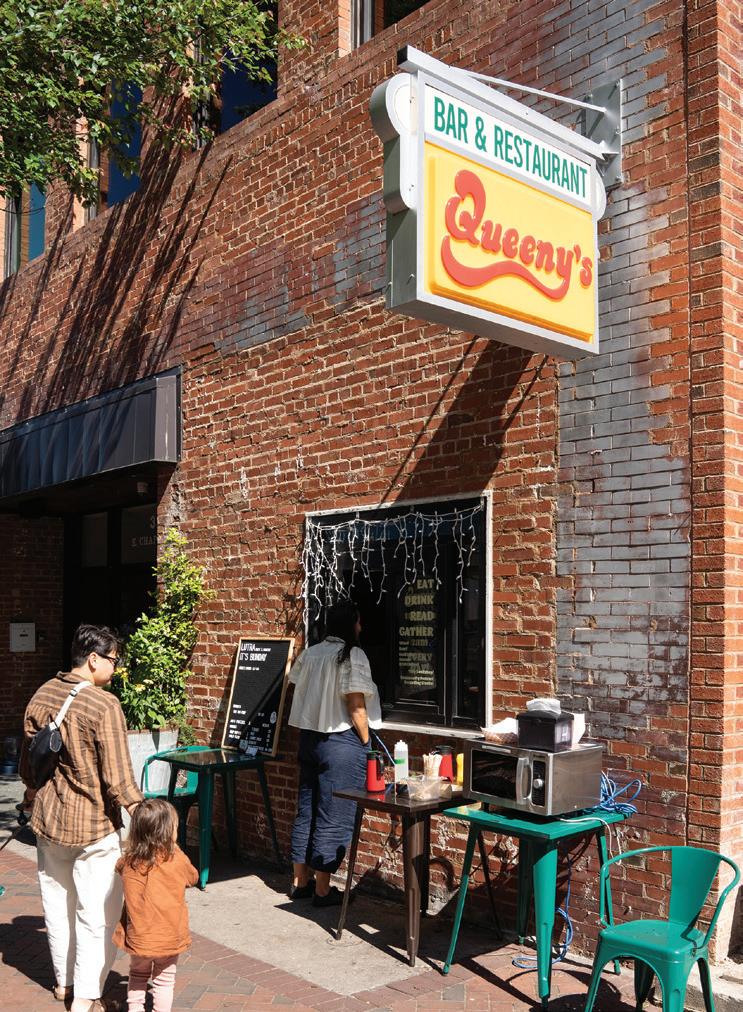
Isaac’s Bagels took over the Queeny’s pop-up window from January until May 2022. Afterward, Isaac’s moved on to the Durham Farmers Market before landing a permanent location on Chapel Hill Street, back near Henrion’s home neighborhood.
“I’d always wanted to have a space in that neighborhood,” Henrion says. “What was really important to me was wanting a shop in a residential neighborhood that would be some people’s local bagel shop.”
Henrion says the business now has about 25 full- and part-time employees, who cover operations at the flagship store and their spot at the farmers market.
“We did look at a few places downtown, but the rents were so high,” Henrion says.
“Eventually, we figured out that 1003 West Chapel Hill Street was back on the market. And that’s what we got. It’s weird, because
the shop is in the space that I had identified, a month after beginning to make bagels at home, as my dream place, and it didn’t work out then. Two years later, it did work out.”
Two more businesses have taken up the mantle at the Queeny’s pop-up window since then. Liturgy, a coffee shop, followed Isaac’s and is now a part of the Durham Food Hall. Lutra, a sticky-bun- and cinnamon-bun-focused baked goods shop, currently operates out of the space on Sundays.
The cost of doing business
Entrepreneurs say that one of the most significant milestones in their business journey is developing an MVP, or minimum viable product. This staple product
INDYweek.com May 29, 2024 21 The INDY FOOD Is su e
People wait in line for Lutra sticky buns during a Sunday pop-up at the Queeny’s window on May 12, 2024. PHOTO BY ANGELICA EDWARDS
serves as the carrot for attracting an initial customer base. For a fast-food restaurant, it could be a hamburger. In the coffee world, a latte. Once the first wave of loyal customers is hooked, the next hurdle is scaling up—going from making two dozen treats for a friend’s dinner party to producing enough inventory for a fullfledged restaurant. Leveling up requires more expensive equipment, Henrion says, which is hard to justify when you’re still a small operation.
“In the beginning, we had a little KitchenAid like everyone has at home. But that only makes so much cream cheese,” Henrion says. “Now, we have a 30-quart mixer. If we were trying to make 400 pounds of cream cheese a week in an eight-quart KitchenAid, not only could you physically not do it, but it’d take a really long time and it would be inefficient and you might throw in the towel because you’re like, ‘This is just too costly. I don’t see the reward.’”
Henrion says that the cost to build out a restaurant space with industrial-sized machines can be prohibitive. Banks offering small-business loans want to validate their decision, so business owners looking to outfit their own brick-and-mortar location need to show potential through a strong customer base and consistent revenue. Herein lies the chicken-and-egg problem. You need more expensive machines to scale up production, but how do you sell enough products to finance the necessary equipment?
Nick and Rochelle Johnson, owners of the Cast Iron Group, set out to solve this paradoxical problem in 2010 when they opened the Cookery, North Carolina’s first privately owned commissary kitchen.
Commissary kitchens are collaborative spaces for aspiring food entrepreneurs to share resources that are too expensive to justify investing in during the early stages of business. Tenants pay to rent the kitchen, giving them access to full-scale ovens, mixers, and other appliances that you can’t just Amazon Prime to your house.
“We have pizza ovens that cost as much as cars—like, nice cars, not entry-level cars like Camrys,” Nick Johnson says.
Business owners then sell their products at pop-up markets or from food trucks, growing their clientele at a manageable rate before making the jump to permanent retail space.
“The goal for us opening the Cookery was not to subsidize the cost of operating in a commercial kitchen, but to remove the barrier to entry of having to bet the farm on your idea before being able to test it out,” Nick Johnson says.
Outfitting a restaurant space can cost
hundreds of thousands of dollars, according to Nick Johnson and others, and equipment costs specific to a culinary pursuit, like pizza ovens, are only a small piece of the pie. New spaces are a blank canvas, often lacking essential infrastructure such as HVAC, electrical wiring, and plumbing. Those investments are expensive and a sunk cost. No one is buying a restaurant’s old HVAC system on Craigslist. Commissary kitchens provide the foundation for restaurants to mitigate those costs.
“We tried to create it in such a way that we didn’t allow people to create a business model based on artificially deflated kitchen costs,” Nick Johnson says. “Because obviously, if they do that, then when they have to go into the real market, the model that they built wouldn’t work when they left. So we weren’t trying to reduce the cost of the kitchen; we were trying to scale the investment required to operate in a kitchen.”
Gold Tacos, a food cart pop-up outside of what was then Remedy Room. The cart sold inexpensive tacos to folks during the lunch rush and hungry night owls exiting the dance floor at upstairs Rubies on Five Points. But overseeing the Lady Gold taco cart proved to be too burdensome on top of Montemayor’s other responsibilities at restaurant Luna and at Rubies, where he is also a co-owner. As the winter months slowed foot traffic downtown, Lady Gold went on hiatus.
This May, after months off, the restaurant made its comeback, this time inside Remy’s Lounge. But the new law, new location, and lingering effects of inflation and the COVID-19 pandemic create new challenges.
“We’re still feeling the effects of the pandemic, and I think it’s not going to end anytime soon,” Montemayor says. “Talk to any business owner that has a bar or restaurant and they can definitely say it’s
“We’re still feeling the effects of the pandemic, and I think it’s not going to end any time soon. Talk to any business owner that has a bar or restaurant and they can definitely say it’s not as good as it was in 2019.”
What happens when a door closes?
Making it into the real market comes with no guarantees. The path to success is rarely without its hiccups, and some entrepreneurs in Durham have had to make lemonade out of unforeseen circumstances.
House Bill 125, a new law that the North Carolina General Assembly enacted last year, changed the definition of bars in the state. As of January 1, any establishment in Durham that serves food requiring time or temperature control for safety is under the inspection purview of the Durham County Health Department (previously, bars could serve limited food menus without inspections).
For Rob Montemayor, co-owner of Remy’s Lounge (formerly Remedy Room) in downtown Durham, the additional oversight means the bar could have to spend thousands to upgrade its kitchen equipment. Last year, Montemayor opened Lady
feel the same way.”
The next course of action
During opening remarks at the May 6 Durham City Council meeting, Mayor Leonardo Williams told the audience that small businesses have fallen on hard times.
“Let me tell you, as a practitioner of it, we are struggling. We are struggling bad,” Williams said.
Williams and his wife, Zweli, own two restaurants, Zweli’s Kitchen and Ekhaya, in downtown Durham. The mayor has been an avid proponent of investing city resources into bolstering the small business economy. During his State of the City address, Williams proposed building a handful of capital improvement projects, including a new convention center and giant sportsplex, to attract more out-oftowners to Durham and drive up revenue for local small businesses and the city’s sales tax base.
“We don’t have enough pull to bring people here,” he said. “We don’t have a big convention center where it’s always full. We’re really relying on the folks that are in this community. I want to say to the small businesses across the city, I hear you, I feel the pain along with you.”
A new convention center might solve long-term economic woes, but small businesses who are struggling today can’t wait. For Durham to maintain its reputation as a foodie town, entrepreneurs will have to rely on the community and their own creativity to find a recipe for success.
not as good as it was in 2019.”
Labor costs are a major challenge that Montemayor and other owners face. Rising cost-of-living expenses mean employers have to increase wages to retain their staff, which often means raising prices. But for Montemayor, opening Lady Gold Tacos was worth the risk.
“I was like, ‘Maybe we should just sell pretzels or something that doesn’t provide labor,’” he says. “Because right now, you can’t hire anybody like you could in ’19. And I get it, because everything is more expensive.”
According to the North Carolina Restaurant and Lodging Association, Durham County has 724 open hospitality positions across the industry.
“I’m trying to pay these guys as much as I can that makes sense to them and makes sense to us,” Montemayor continues. “If I could pay these guys $50,000 a year, I would. I’m sure a lot of business owners
The Can Opener, a “food truck rodeo”–style space that hosts permanent food truck businesses run by the co-owners, as well as a rotation of guest restaurants, is opening later this year. For established businesses trying to rebound, another option is fundraising, as the owners of COPA have been doing recently.
Asking for help from the community in this way, Henrion says, is the first step. Someone else will hold the door, or window, open for you.
“The thing I always encourage people to do when they get in touch with us and ask for advice, the number one thing that we’ve done well and that has benefitted us, is just ask random people for help a lot,” Henrion says. “A lot of people don’t know that they can just ask for help, or are kind of afraid of doing so. They feel like maybe someone’s going to say no, or it’s going to be embarrassing. It’s about having the confidence to just be like, ‘Hey, can you help me do this?’ And people just say yes. People like helping each other.” W
22 May 29, 2024 INDYweek.com



INDYweek.com May 29, 2024 23

The Truck Stops Here
Que Chula Es Puebla, a family-run Raleigh food truck, serves up Pueblan dishes with care.
BY GABI MENDICK food @indyweek.com
Had you tried to seek out Pueblan food in the area a few years ago, you would’ve come up short. While local Mexican fare is widely available around the Triangle, regional food is still somewhat limited. Case in point: despite the number of Mexican restaurants, grocery stores, and food trucks in the area, until recently, none offered regional Pueblan fare.
That changed in 2021 when the Vega family (Luis Miguel, his wife Angeles, and their children Luis Vazquez, Edwin Vazquez, and Jouse) opened Que Chula Es Puebla. The truck showcases matriarch Angeles’s traditional cooking from her hometown of Puebla, the capital city of the Mexican state that holds the same name.
Que Chula Es Puebla can be found parked at 2601 South Saunders Street in Raleigh next to a Mexican market and a Boost Mobile. Wrapped in photos of featured dishes and images of Pico de Orizaba, a striking volca-
no in Puebla, the colorful truck is open Monday through Saturday.
“We used to go all the way to New York to buy cemitas,” Luis Vazquez recounts customers saying, regarding the business’s presence in Raleigh. “Now we have them like 20 or 30 minutes away, not eight or nine hours.”
“I honestly have a lot of plates that you won’t see at other food trucks,” Luis Vazquez says. He’s talking about the huitlacoche quesadillas—handmade corn tortillas with quesillo (Oaxaca cheese), chicharron, and huitlacoche, or corn smut. Huitlacoche, a dark fungus that grows on the ears of corn, may not sound or look appealing to the untrained eye, but it has an earthy, intense umami flavor quite unlike anything else.
Puebla is located about two hours southeast of Mexico City. Its origins as a state go back to the 16th century, when Spanish colonizers established a city along the
trade route between Mexico City and Veracuz. This has shaped the region’s cuisine, with ingredients brought from Europe and products like olive oil, wheat, and almonds incorporated into dishes that are now considered quintessentially Pueblan. Three decades later, Mexico’s defeat of the invading French army at Puebla on May 5, 1862, became a key event in the state’s, and country’s, history—a day now marked by the familiar festival Cinco de Mayo.
“We are the closest taste you can have to Pueblan food in the U.S. in this area,” Luis Vazquez says. “Everything is different, you won’t ever have that same taste, but we come close to it.”
Luis Vazquez’s parents came to the United States from Puebla in their late teens. Before embarking on this joint venture, Luis Miguel worked in construction and Angeles owned and operated a cleaning business. Angeles had always cooked Pueblan dishes at home but never dreamed of opening a food business, Luis Vazquez says, but several years ago, he encouraged her to share her cooking with a bigger audience.
“I know the cooking is really good—I’m not just saying that because she’s my mom,” Luis Vazquez explains. “I wouldn’t give her the idea if it wasn’t good. So we went ahead and did it.”
The entire Vega family works at Que Chula, each contributing to various aspects of the kitchen and business. Luis Vazquez and Edwin are currently studying to become an HVAC technician and barber, respectively, and the truck’s schedule is coordinated around respective responsibilities. All hands are on deck in this family pursuit, easing the stress of owning and operating a business with the many unexpected hurdles of running a food service operation.
24 May 29, 2024 INDYweek.com The INDY FOOD Is su e
The Que Chula Es Puebla food truck PHOTO BY ANGELICA EDWARDS
Inflation has been one such hurdle: Customers expect food truck menus to be cheap, irrespective of the economy. But while the initial cost of opening a food truck is small in comparison to opening a brick-and-mortar restaurant, day-to-day costs still make for slim profit margins. Luis Vazquez notes that the steadily rising costs of ingredients made cheap eats less feasible at Que Chula—the cemita, which can easily feed two, will cost you $17, and a plate of three memelas comes in at $15. But once customers try the menu, he says, they are usually on board, recognizing the high quality and value of the dishes.
One of the dishes not to be missed are the tacos árabes. The origins of tacos árabes, or Arab tacos, are often traced to the early 20th century, when there were waves of immigration from Syria and Lebanon to various regions of Mexico, including Puebla. The taco, a fusion dish with both Mexican and Middle Eastern influences, has become a Pueblan staple. Marinated pork filling is traditionally cooked on a spit, similar to shawarma. Unlike more familiar street tacos that are served in corn tortillas, these are served in a slightly thicker and chewier flour tortilla called pan árabe, which has some resemblance to laffa, the flatbread traditionally used for shawarma.
“Nobody really knows why they’re called tacos árabes,” Luis Vazquez recounts, trying to get to the bottom of their origin story. “I want to know, I want to find out. I went to Puebla and I started asking around; they gave me theories, but nobody really knows why.”
Another popular Pueblan dish the family serves is the cemita. At Que Chula, the bread for this monstrosity of a sandwich, baked fresh every morning, is a perfect canvas for the fillings. Cemitas are served with a choice of chicken or beef milanesa, a breaded and fried cutlet, which is piled high with thick shreds of quesillo, avocado, and your choice of papas fritas or chipotle chilies. The crispy fried meat, stretchy cheese, creamy avocado, and sweet and spicy chilies balance out each bite.
The memelas poblanas served at Que Chula are another classic: handmade corn tortillas are stuffed with beans and topped with quesillo, salsa, onions, and meat. Luis Vazquez notes that, though it isn’t traditional, he grew up eating memelas with sour cream—and continues to snack on them this way.
Fusion foods and modern takes on traditional dishes are sometimes intentionally invented by conceptual chefs. But just as often, these evolutions and creations occur accidentally as people, and the foods they bring with them, migrate to new places. Whether tacos árabes on Pueblan street corners, or memelas topped with sour cream, foods evolve, telling the stories of where their creators came from.
Driving down Saunders Street, Que Chula Es Puebla might look like any other taco truck, but looks can be deceiving. This food truck’s attention to detail and commitment to creating authentic Pueblan dishes, with dishes made entirely from scratch, make this family-run food truck a unique destination worth seeking out. W


INDYweek.com May 29, 2024 25
Tacos árabes at the Que Chula Es Puebla food truck
PHOTO BY ANGELICA EDWARDS
Norwegian Mountains, Vicious Satire, and Shifting Perspectives
Norwegian documentary “Songs of Earth,” gonzo black comedy “Do Not Expect Too Much from the End of the World,” and other movies coming soon to local theaters
BY GLENN MCDONALD arts@indyweek.com

Whenever America gets me depressed— which is several times daily, of late—I try to remind myself that the world is a bigger place. Getting out into nature is a good way to find that perspective. Going out to the movies is another, especially if you seek out international films.
The Norwegian documentary Songs of Earth combines these strategies into a film that promises a dramatic renewal of perspective. Directed by veteran filmmaker Margreth Olin, the documentary profiles Olin’s 85-year-old father, who has lived his entire life in one particular valley beneath the majestic mountains of Norway. Olin spent a full year with her father, filming the cycle of seasons that have passed through their valley for millions of years.
Critics are praising the film’s magnificent cinematography, and this is certainly the kind of film you want to see on a big screen. Pair that with the story underneath—a daughter bonds with her father in the late autumn of his life—and you’ve got a movie that is all about perspective. Songs of Earth engages with big themes—nature, family, time. It should be good medicine for anyone feeling the crush these days.
Keeping with the theme of alternate perspectives, the new film from Romanian director Radu Jude offers a different point of view for the discerning foreign film enthusiast. Do Not Expect Too Much from the End of
the World is a kind of gonzo black comedy— structurally experimental, consistently rude, and by all accounts, very funny.
Plotwise, Jude’s film follows the adventures of Angela, an underpaid Bucharest production assistant tasked with driving around the city to shoot footage for a soulless corporate training video. The film’s actual topic, however, is what it’s like to live in these seemingly terminal days of a world gone mad—suicidal greed, willful ignorance, economic inequality, pervasive cruelty. We’re all familiar, I think.
You’ll want to find the (NSFW) trailer online to get a sense of the film’s ferocious satire. It’s a kind of flipside approach to the perspective shift. Rather than running off to the serenity of the mountains, Jude invites us to lean into the death spiral and laugh. It’s hard to find a movie like this in American theaters anymore. Think of it as a gift from Romania’s indie filmmaking community. Thanks, guys.
For a third option this month, check out The Bikeriders, a historical drama concerning the downfall of a Chicago motorcycle gang circa 1965. This makes the list primarily due to director Jeff Nichols, alumnus of the UNC School of the Arts, who always makes interesting movies. The cast includes Nichols’s longtime collaborator Michael Shannon, plus Tom Hardy and the hypnotic Jodie Comer from the BBC’s Killing Eve.

QUICK PICKS
For yet another international film option, check out the Turkish drama About Dry Grasses, which played to very good reviews at the Cannes Film Festival last year.
Two superior sci-fi franchise installments are in theaters just now, George Miller’s Furiosa: A Mad Max Saga and the surprisingly excellent Kingdom of the Planet of the Apes. Pixar is back on June 14 with Inside Out 2,
sequel to the great 2015 original. The first film’s anthropomorphic emotions are joined by a new teenage-specific squad, including Anxiety, Embarrassment, and Ennui. That sounds right.
For arthouse old-timers who still appreciate a British period drama, Firebrand stars Alicia Vikander as Katherine Parr, the last of Henry VIII’s six wives and the one who finally put the old bastard in the ground. W
26 May 29, 2024 INDYweek.com INCOMING! INCOMING! Do
Expect
from
End of the World COURTESY OF 4 PROOF FILM
Not
Too Much
the
Songs of Earth COURTESY OF SPERANZA FILMS
5/31
MUSIC
The Magnetic Fields: 69 Love Songs 25th Anniversary Tour May 29-30, 8 p.m. The Carolina Theatre, Durham.
Ruckus Rock Revival 7 p.m. Sarah P. Duke Gardens, Durham.
STAGE
Jane Eyre May 29–June 9, various times. Theatre Raleigh, Raleigh.
The Lion King May 29–June 9, various times. DPAC, Durham.
MUSIC
An Evening with Brian Culbertson 7:30 p.m. Joseph M. Bryan Jr. Theater in the Museum Park, Raleigh.
Orville Peck: 2024 North American Tour 6:30 p.m. Red Hat Amphitheater, Raleigh.
STAGE
Grand Horizons, Presented by Honest Pint Theatre Co. 7:30 p.m. TR Studio, Raleigh.
The Great Beyond May 30–June 16, various times. Kennedy-McIlwee Studio Theatre, Raleigh.
PAGE
Pete Candler: A Deeper South 6:30 p.m. Letters Bookshop, Durham.
MUSIC
Charming Disaster / Curtis Eller 7:30 p.m. Shadowbox Studio, Durham.
Good Moon Festival hosted by Sylvan Esso May 31-June 1, Various times. Durham Bulls Athletic Park, Durham.
Freight Train Blues Fridays at 6:30 p.m. Carrboro Town Commons, Carrboro.
Intimate Evening with Grammy Award Winner Susan Carol Various times. Missy Lane’s Assembly Room, Durham.
Medium Heat / Megayacht 7 p.m. Neptunes, Raleigh.
Michael Hawkins and the Brotherhood 7:30 p.m. Sharp 9 Gallery, Durham.
North Carolina Symphony: Summerfest Salute to John Williams 8 p.m. Koka Booth Amphitheatre, Cary.
Triangle Gay Men’s Chorus Concerts 7 p.m. Pullen Memorial Baptist Church, Raleigh.
STAGE
The ComedyWorx Show 8 p.m. ComedyWorx, Raleigh.
The Harry Show 10 p.m. ComedyWorx, Raleigh.
Hush Hush: Comedy Based on Secrets 9 p.m. Mettlesome Theater, Durham.
Planet Rave 9 p.m. The Fruit, Durham.

Small Town Murder Podcast 2024 Tour 8 p.m. The Carolina Theatre, Durham.
Stone Soup presents The Spitfire Grill May 31–June 8, various times. Center Theater Company, Carrboro.
ART
Opening Reception: Local Artists Forum Group Exhibition 6 p.m. Cary Gallery of Artists, Cary.
PAGE
Thomas Wolfe Society Conference May 31–Jun 1, 11 a.m. Durham Arts Council, Durham.
MUSIC
Beaux Mondes: Swinging Speakeasy Jazz 7 p.m. Succotash Durham, Durham.
Family Fun 4 Everyone: Sensory-Friendly Concert 1 p.m. Meymandi Concert Hall at Martin Marietta Center for the Performing Arts, Raleigh.
Gabe Soileau and the Carolina Zydeco Band 7 p.m. Yonder Southern Cocktails and Brew, Hillsborough.
The Hour Glass Kids June 1-2, 9 p.m. Speakeasy, Carrboro.
NC DR Live 7 Block Party and Mental Health Benefits Concert 2 p.m. Moore Square, Raleigh.
ROCK FOR HOPE: Breast Cancer Benefit Concert 7 p.m. Five Oaks Clubhouse, Durham.
Triangle Gay Men’s Chorus Concert featuring Oak City Saxes 7 p.m. Eno River Unitarian Universalist Fellowship, Durham.
INDYweek.com May 29, 2024 27 LIKE TO PLAN AHEAD?
FRI
SAT
WED 5/29 THURS 5/30
6/1
Country singer Orville Peck is headed to Red Hat Amphitheater on May 30. PHOTO COURTESY OF RED HAT AMPHITHEATER
R E
E N DA R
C U LT U
CA L
6/1 SUN 6/2 MON 6/3
STAGE
Harold Night 8:30 p.m. Mettlesome Theater, Durham.
House Party 7:30 p.m. Mettlesome Theater, Durham.
The Monti: In Too Deep 8 p.m. The Carolina Theatre, Durham.
ART
Megan Gulledge: The Memories I’m Bound To 7:30 p.m. The Fruit, Durham.
SCREEN
Back Porch Films Local Filmmaker Showcase 7 p.m. Durty Bull Brewing Company, Durham.
COMMUNITY
20th Annual Beaver Queen Pageant 4 p.m. Duke Park, Durham.
Chapel Hill Pride Promenade 12 p.m. Peace and Justice Plaza, Chapel Hill.
Wake County Queer Prom 2024 for High School Students Jun 1-2, 6 p.m. Hilton Raleigh North Hills, Raleigh.
MUSIC
Al Strong Jazz Sundays at 12 p.m. Alley Twenty Six, Durham.
STAGE
Desi Banks: The Purpose Chaser Tour 8 p.m. The Carolina Theatre, Durham.
No Shame Theatre 4 p.m. Carrboro Century Center, Carrboro.
MUSIC
Cosmic Chuckles Stand Up Comedy Night 9 p.m. Flying Saucer Draught Emporium, Raleigh.
TUES 6/4
MUSIC
Jeremy “Bean” Clemons Tuesdays at 8 p.m. Kingfisher, Durham.
Megan Thee Stallion 7 p.m. PNC Arena, Raleigh.
Tim Smith 5 p.m. Speakeasy, Carrboro.
PAGE
Joanna Pearson: Bright and Tender Dark 5:30 p.m. Flyleaf Books, Chapel Hill.
WED 6/5
MUSIC
Ally J on the Roof 7:30 p.m. The Durham Hotel, Durham.
Charly Lowry and the Lowrie Gang 7 p.m. Sarah P. Duke Gardens, Durham.
John Fogerty: 2024 Celebration Tour 7 p.m. Red Hat Amphitheater, Raleigh.
SCREEN
NCMA Matinee: 8 1/2 2 p.m. Joseph M. Bryan Jr. Theater in the Museum Park, Raleigh.

THURS 6/6
MUSIC
Lonnie Walker / Family Vision / Exercise 7 p.m. Oak City Cycling Project, Raleigh.
Samara Joy / SuperBlue 7 p.m. Joseph M. Bryan Jr. Theater in the Museum Park, Raleigh.
STAGE
Comedy Improv with Stolen Identity and Friends 7 p.m. Succotash Durham, Durham.
Ex-Boyfriends: WTYST Second Stage Series June 6-22, various times. Burning Coal Theatre Company, Raleigh.
Redwood June 2-23, various times. 7:30 p.m. Mettlesome Theater, Durham.
The Uproar: Murder, Monsters, and Media June 6-8, 8 p.m. Moonlight Stage Company, Raleigh.
PAGE
M. K. Asante: Nephew: A Memoir in 4-Part Harmony 5:30 p.m. Flyleaf Books, Chapel Hill.
Nita Tyndall: Have You Seen This Girl? 6:30 p.m. Letters Bookshop, Durham.
SCREEN
2020: A Pandemic Odyssey 8 p.m. Shadowbox Studio, Durham.
28 May 29, 2024 INDYweek.com
OUR COMPLETE COMMUNITY CALENDAR AT INDYWEEK.COM/CALENDAR
FIND
SAT
This year’s Chapel Hill Pride Promenade takes place at Peace and Justice Plaza on June 1. PHOTO COURTESY OF THE TOWN OF CHAPEL HILL
(cont.) C U LT U R E CA L E N DA R
FRI
6/7
MUSIC
Emily Musolino 9 p.m. Speakeasy, Carrboro.
Freight Train Blues Fridays at 6:30 p.m. Carrboro Town Commons, Carrboro.
Jazz at the NCMA Presents an Evening with Babyface 7:30 p.m. Joseph M. Bryan Jr. Theater in the Museum Park, Raleigh.
Lovell Bradford Quartet featuring Sean Jones and Stacy Dillard 7:30 p.m. Sharp 9 Gallery, Durham.
Niall Horan: The Show Live on Tour 7:30 p.m. Coastal Credit Union Music Park at Walnut Creek, Raleigh.
Rob Gelblum 6 p.m. Lanza’s Cafe, Carrboro.
North Carolina Symphony Summerfest: Light Classics 8 p.m. Koka Booth Amphitheatre, Cary.
STAGE
Beer Garden Comedy Showcase 8 p.m. The Glass Jug Beer Lab, Durham.
The ComedyWorx Show 8 p.m. ComedyWorx, Raleigh.
The Harry Show 10 p.m. ComedyWorx, Raleigh.
Hush Hush: Comedy Based on Secrets 9 p.m. Mettlesome Theater, Durham.
SCREEN
2024 Southern Documentary Convening June 7-9, various times. The Fruit, Durham.
MUSIC
Brothers Osborne: Might As Well Be Us Tour 8 p.m. Red Hat Amphitheater, Raleigh.
Ilya Lushtak Quartet
7:30 p.m. Sharp 9 Gallery, Durham.
North Carolina Symphony Summerfest with the Steep Canyon Rangers 8 p.m. Koka Booth Amphitheatre, Cary.
STAGE
Cold Brew Comedy Show 7 p.m. Lanza’s Cafe, Carrboro.
The Dinner Detective
Comedy Mystery Dinner Show 6 p.m. Embassy Suites by Hilton Raleigh Crabtree, Raleigh.
PAGE
Cait West: Rift 3 p.m. Flyleaf Books, Chapel Hill.
Cait West and Anna Gazmarian St. Joseph’s Episcopal Church, Durham.
MUSIC
Al Strong Jazz Sundays at 12 p.m. Alley Twenty Six, Durham.
Bryson Tiller: 2024 Back and I’m Better Tour 7:30 p.m. Red Hat Amphitheater, Raleigh.
Christopher Law Trio 11 a.m. Lanza’s Cafe, Carrboro.
PAGE
Poetry Series: Anne Myles and Richard Allen Taylor 2:30 p.m. Flyleaf Books, Chapel Hill.
STAGE
Cosmic Chuckles Stand Up Comedy Night 9 p.m. Flying Saucer Draught Emporium, Raleigh
6/11
MUSIC
Jeremy “Bean” Clemons Tuesdays at 8 p.m. Kingfisher, Durham.
Khruangbin: A La Salas Tour 7 p.m. Red Hat Amphitheater, Raleigh
PAGE
Sigrun Bredkjær Brodey presents Jane Austen and the Price of Happiness 5:30 p.m. Flyleaf Books, Chapel Hill.

INDYweek.com May 29, 2024 29 LIKE TO PLAN AHEAD? SAT
SUN
MON
TUES
6/8
6/9
6/10
BOOTH AMPITHEATRE
North Carolina’s own Steep Canyon Rangers join the NC Symphony for an evening of bluegrass, Americana, and folk rock at Koka Booth Amphitheatre on June 8. PHOTO COURTESY OF KOKA
U
E N DA R
C
LT U R E CA L

CROSSWORD
To download a pdf of this puzzle or view its solution, visit indyweek.com/puzzles-page


SU | DO | KU
© Puzzles by Pappocom
Difficulty level: HARD
There is really only one rule to Sudoku: Fill in the game board so that the numbers 1 through 9 occur exactly once in each row, column, and 3x3 box. The numbers can appear in any order and diagonals are not considered. Your initial game board will consist of several numbers that are already placed. Those numbers cannot be changed. Your goal is to fill in the empty squares following the simple rule above.

If you’re stumped, find the answer keys for these puzzles and archives of previous puzzles (and their solutions) at indyweek.com/puzzles-page or scan this QR code for a link. Best of luck, and have fun!
30 May 29, 2024 INDYweek.com INDY CLASSIFIEDS classy@indyweek.com
P
U Z Z L E S


EMPLOYMENT
Associate Principal Statistical Programmer
Associate Principal Statistical Programmer, IQVIA RDS Inc., Durham, NC. Must telecom frm anywhre in US. Gen & QC anlysis datasets, summary tbles, data lstngs & graphs for in-house anlyses of study data/ pubs w/ SAS stndrd codng prctcs. Salary: $147,740 - $177,000/yr. Reqs at least bach in Stat, Biostat, Math, Comp Sci, IT, Reg Affairs, Biotech, Life Sci/ rel/ equiv. Reqs 5 yrs stat prog exp incl 5 yrs: use SAS/R prog; implemnt all SOPs, Guidelines & Wrk Instrctions; intrprt, mod, & adpt compny stndrds, proj specs, tasks & goals; Pharma clin dev incl sfty delvrble undrstnd & efficacy anlysis spprt reg submssn; SAS, proc rprt, expsure to macros, currnt CDISC data structurs, stndrdztn methodlgy & debug SAS progs; Define.xml, Pinnacle 21, aDRG, & sDRG; SAS Macro prog, SAS SQL, XML, RTF, & PDF. Apply: resume to: usrecruitment@ iqvia.com & ref#111482.
Manager Software Engineering
Manager Software Engineering, Brightly Software, Inc., Cary, NC. May teleco in US (EST hrs). Mng engg team assoc w/ Event Mgr prod line. Supv 3-4 subords. Reqs Bach in CS /rel / equiv. Reqs 5 yrs exp in Agile sw dev envir. In lieu of Bach & 5 yrs, will accpt 7 yrs exp in Agile sw dev envir. Exp mst incl (w/i Bach 5 yrs / w/out deg 7 yrs): leadng engg as sw dev team lead /mgr; mkng arch decisions to imp prod /fulfill bus need; use mod SDLC pract incl CI/CD, unit tstng, & regress tstng; .NET pltfrms; C#; & SQL Serv. M-F 8a-5p & aft hrs if req’d. Hires submit to bg chk. Send res to: betsy.sisley@ brightlysoftware.com & ref #110687.
Software Developer
SAS Institute Inc. seeks Software Developer in Cary, NC to implement the next generation SAS Studio mid-tier architecture. Reqs: BS in Comp Sci, Comp Eng, or rel + 5 yrs exp. May work remotely pursuant to SAS’ Flexible Work Prgm. For full reqs & to apply visit www.sas.com/careers and reference Job # 2024-35933.
Taekwondo Coach
Taekwondo Coach sought by MCMA Chapel Hill LLC (1129 Weaver Dairy Rd, Ste E, Chapel Hill, NC 27514) Teach & supv athletes as they complete rigorous training regimen in prep’n for regional & national Taekwondo tournaments. Teaches students various techniques in the sport of Taekwondo, as well as hones their skills & prep them for different competitions. Min. Bach’s in Physical Edu & Blackbelt (Dan Certificate) in Taekwondo is required. Resume: Cristiano Polilli (COO), 1129 Weaver Dairy Rd, Ste E, Chapel Hill, NC 27514.

INDYweek.com May 29, 2024 31 classy@indyweek.comINDY CLASSIFIEDS classy@indyweek.com C L A S S I F I E D S HEALTH & WELL BEING 919-416-0675 www.harmonygate.com
5/15/24 CROSSWORD SOLUTION SERVICES


























































































































































































